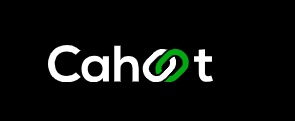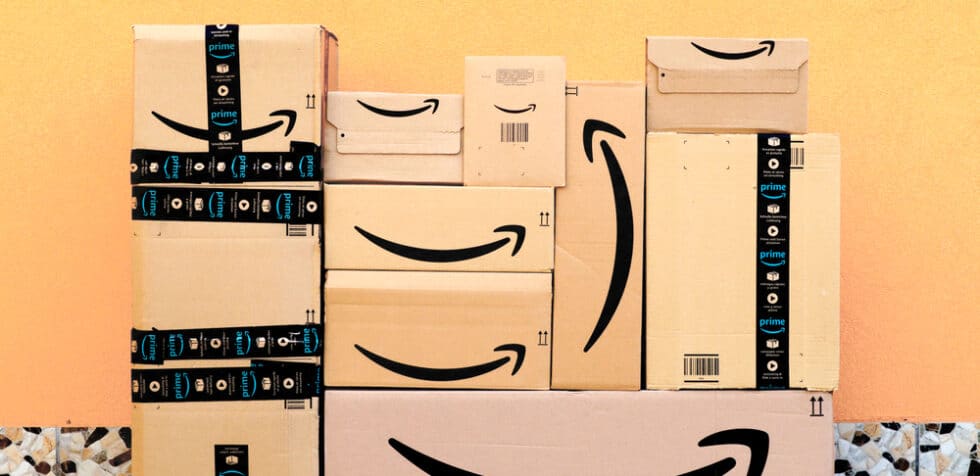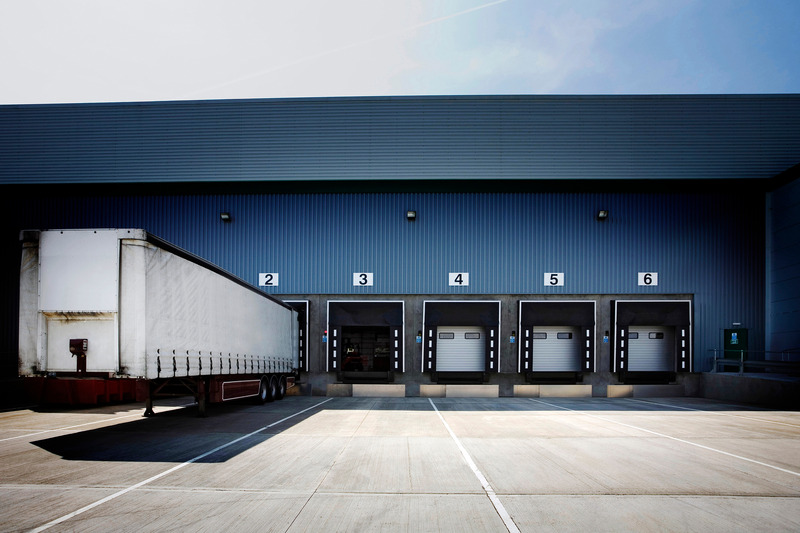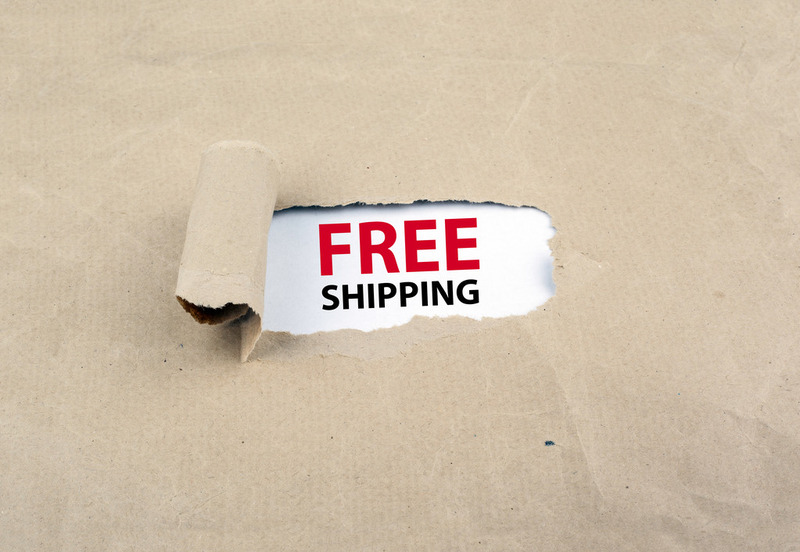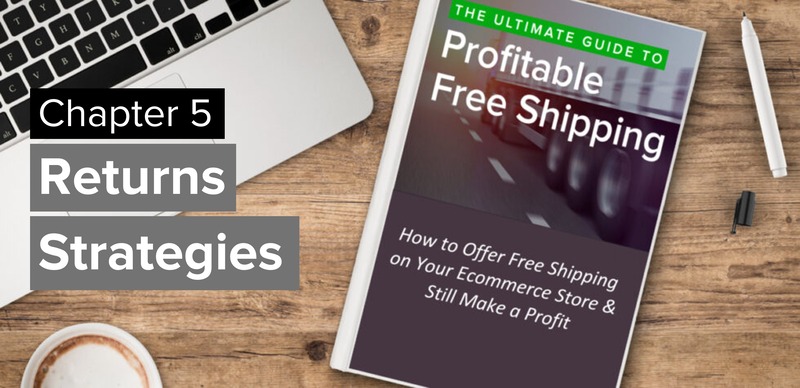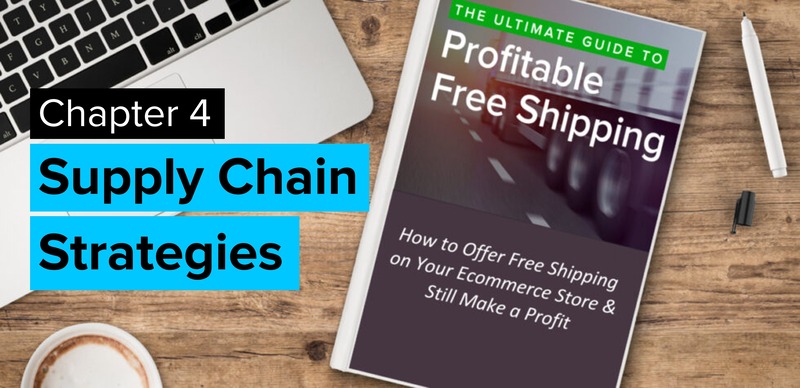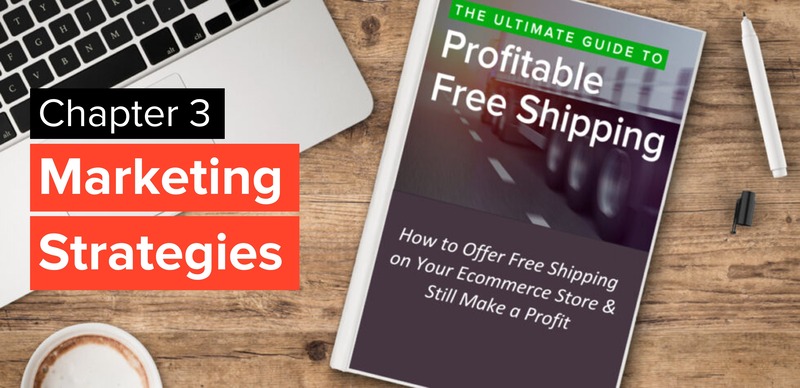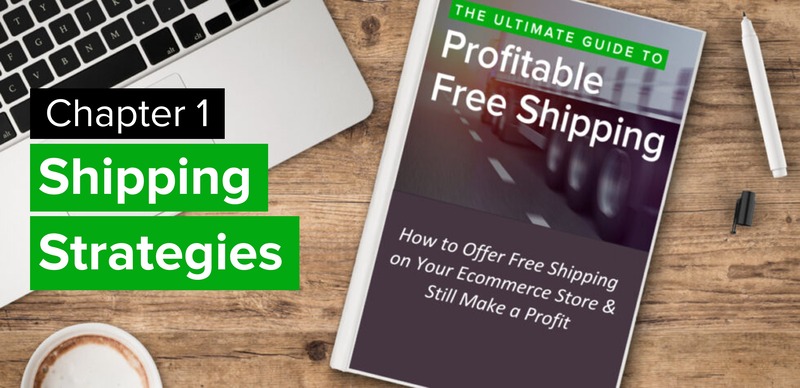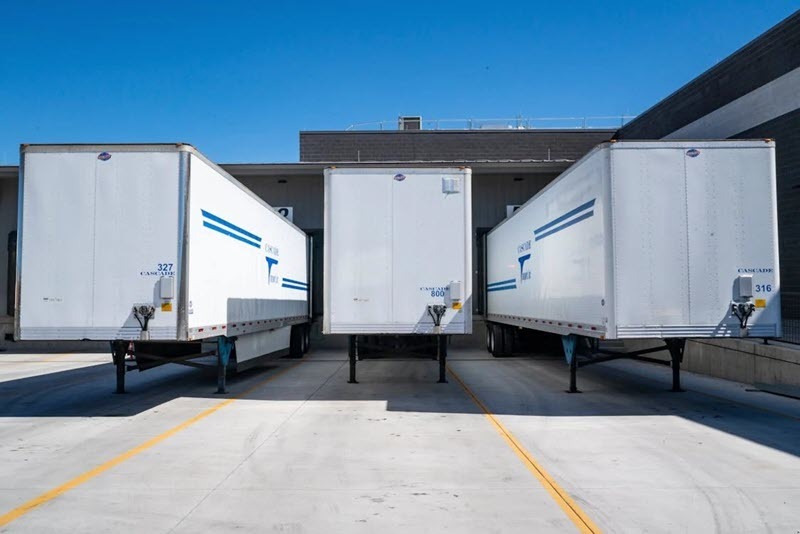The Ultimate Guide to Selling and Winning on Amazon Seller Fulfilled Prime
In this article
 30 minutes
30 minutes
- What is Seller Fulfilled Prime?
- SFP – Now More Relevant For Sellers Than Ever Before
- Diversify Beyond FBA
- Seller Fulfilled Prime – An Essential Tool for Ecommerce Growth
- The Competitive Advantages of Seller Fulfilled Prime
- Succeeding at SFP is Hard – Here’s Why
- The Cheat Sheet for Winning at Seller Fulfilled Prime
- Frequently Asked Questions
Watch On-Demand Webinar:
Amazon SFP – How To Sell and Win
In June 2023, Amazon announced they would reopen enrollment for their Seller Fulfilled Prime (SFP) program. Like most things in the Amazon world, the news was received with mixed reactions by Sellers. For those familiar with the Amazon ecosystem, they know that this program is challenging. Many feel the list of requirements is daunting and that Amazon holds them to higher standards than the ones it sets for its in-house Fulfilled By Amazon (FBA) logistics network.
Most people are familiar with the requirements that Amazon expects Sellers to meet, but far fewer are aware of the roadblocks that make success hard to achieve. An even smaller number are aware of the strategies they can deploy to meet Amazon’s criteria and surpass them. We’ve outlined all of that and more in our Ultimate Guide:
- We start by helping you understand what the program actually is and its benefits.
- Despite the daunting SFP requirements, the reward can be immense – we highlight the value that success in the program can deliver to your business.
- However, SFP success is not easy, and many Sellers find the program extremely challenging – we do a deep dive into the most common stumbling blocks that trip up even experienced Amazon merchants.
- Finally, we give you an essential cheat sheet needed to start selling and winning on Amazon Seller Fulfilled Prime!
One critical aspect to consider is the Seller Fulfilled Prime cost. Understanding the financial implications, including the program fee per item sold, percentage fees, and minimum fees, is essential for assessing potential profitability and managing profit margins effectively.
What is Seller Fulfilled Prime?
Before we do a deep dive, it’s essential to understand – what is the Seller Fulfilled Prime program?
Definition and Benefits of Seller Fulfilled Prime
Seller Fulfilled Prime (SFP) is a program offered by Amazon that allows third-party Sellers to display the Prime badge on their listings while maintaining control over their fulfillment process. This means sellers can ship Prime orders directly to customers within two days, ensuring fast and reliable delivery. By participating in SFP, sellers can significantly boost their visibility, credibility, and sales potential, all while providing an enhanced customer experience.
The benefits of SFP include:
- Increased Visibility and Credibility: Listings with the Prime badge are more likely to be seen and trusted by customers.
- Greater Control: Sellers have more options and control over their fulfillment process and inventory management compared to using Fulfilled by Amazon (FBA).
- Brand Building: Sellers can build their brand, including flexibility to provide unique experiences for customers, such as custom packaging, while maintaining Prime status.
- Increased Sales and Profits: The Prime badge can lead to higher sales and better profit margins.
- Amazon’s Customer Service: Access to Amazon’s customer service and support for handling customer service inquiries, but the ability to own customer service if desired.
- Lower Fees: Freedom from the high fees associated with Amazon FBA.
- Improved Support for Challenging SKUs: The ability to meet the consumer expectation for free and fast shipping even on slow-moving, seasonal, larger-sized, and heavier SKUs.
While all these are great, the biggest one for any Seller is that the program allows your product listings on the Amazon Marketplace to feature the coveted Prime badge. With over 180 million subscribers in the United States in 2025, Amazon’s loyalty program has a great promise for the end customer – pay $139 (plus taxes) annually, and Amazon will deliver you stuff for free in under two days.
The program has far more profound implications for Sellers – their ranking on Amazon search results and ability to win the “Buy Box” is heavily and positively influenced by ensuring their products are Prime eligible. It’s also no secret that most shoppers on Amazon toggle the filter when browsing the store just to see products that qualify for Prime. All this means that an Amazon merchant’s survival, let alone success, largely depends on ensuring each SKU is Prime-eligible.
Seller Fulfilled Prime offers Sellers the best of both worlds – the Prime badge and autonomy over order fulfillment. However, it isn’t all smooth sailing, and Sellers have tended to shy away from the program because of its exacting standards. However, there are indications that the present time is a good one to begin seriously considering enrolling in the program.
“Cahoot has amazing technology in addition to their large warehouse network, sort of like FBA but without the hefty fees or restrictions. Cahoot saved our peak-selling season!”
~ Joel Frankel, Fames Chocolates
Speak to a fulfillment expert
How Seller Fulfilled Prime Works
To participate in SFP, sellers must meet Amazon’s stringent performance requirements. These include:
- Own Warehouse: Sellers must have their own warehouse, (or partner with a robust and capable modern 3PL), and an Amazon Professional Seller account.
- Premium Shipping Options: Offering premium shipping options to customers.
- Exceptional Performance Metrics: Consistently exceeds for the On-Time Delivery, Valid Tracking, and Delivery Speed metrics while maintaining a very low Order Cancellation Rate.
- Supported Carriers: Delivering orders with Amazon’s approved Seller Fulfilled Prime carriers.
- Amazon Returns Policy: Agreeing to the Amazon Returns Policy.
Sellers must also complete a trial period, during which they must fulfill at least 100 Prime packages while adhering to all of Amazon’s strict shipping requirements. Once the trial period is successfully completed, the Prime badge will be displayed on their listings, granting access to Prime customers. More on this later.
SFP – Now More Relevant For Sellers Than Ever Before
Several reasons have combined to make Seller Fulfilled Prime more relevant than ever before for Sellers, some of Amazon’s own making along with others that are not as palatable to the company:
The “Prime Effect”: Everybody Wants Fast Shipping
When Amazon first introduced Prime in 2005, it announced that it would ship customer orders over $35 for free in 2 days. At the time, people in the industry thought that the company had lost its mind and that this strategy would surely fail. It took competitors over a decade to offer free 2-day shipping – retailers like eBay and Walmart introduced their competing services only in 2017.
However, when Prime moved from its 2-day timeline to free 1-day shipping in 2019, Walmart and BestBuy responded almost immediately, offering customers the same experience. That captures just how much Amazon has raised the bar and redefined customer expectations – the Prime effect means that all of us expect everything delivered in under two days for free.
The stakes are high for ecommerce merchants across every channel – it does not matter whether you serve customers through a Shopify storefront, eBay, Amazon, or Walmart – you have to meet the consumer expectation for fast order fulfillment.
Shipping is no longer a back-office operation; it has become the defining element of the customer experience.
The company that created the Prime Effect is arguably the most customer-obsessed organization in the world. For years, Amazon has focused relentlessly on creating value for its customers – often at the expense of Sellers on its platforms. At every turn, the company has weaponized the size of its customer base and the network effects of its marketplace model to squeeze Sellers while delighting customers.
People, regulators, and governments aiming to call out the company on some of these practices have been met with a frequent refrain, “As long as the end customer is happy, how does it matter?” But why are customers so happy with Amazon, and how does the company have so many of them (most of whom are Prime members)? The most important reason is Amazon’s ability to ship products in under two days, nearly always on time.
“Cahoot allows us to offer 2-day shipping on our website in addition to driving more sales nationwide SFP on Amazon. This app saves us a ton of time and money every single day!”
~ OZ Medical
Speak to a fulfillment expert
Diversify Beyond FBA
For Sellers operating on Amazon, the approach has often been relatively straightforward: let Amazon FBA take care of it all and only use Fulfilled By Merchant (FBM) or SFP as a backup in the rare event of an emergency. However, given how FBA has repeatedly proven to quickly and substantially change program requirements and fees, a backup may no longer suffice – Sellers may need to devise an entirely new order fulfillment strategy.
Sellers Have Traditionally Relied on FBA
According to Jungle Scout, 64% of Amazon Sellers use FBA exclusively to deliver their orders, with only 14% choosing to completely cut ties with FBA and handle everything independently.
There are good reasons for this – the algorithm determining whether a product listing will win the Buy Box uses fast order fulfillment as a leading criterion. The fact that FBA listings are automatically Prime eligible is attractive for many Sellers (SFP listings also have a great chance to win the Buy Box, while merchant-fulfilled non-Prime orders trail well behind).
The well-known A10 algorithm, which ranks products in search results on Amazon, also prefers listings with fast order fulfillment, which has led Sellers to lean in heavily on FBA (again, a Seller Fulfilled Prime order can show up favorably, subject to the merchant doing other things right, such as optimizing for the right keywords in their product detail page copy).
The question Sellers might ask is: why would I do all the extra work required by SFP listings when it’s easier to win the buy box and rank well with FBA alone? To answer the question with a question: why not both? Not only do you get more shots on the Buy Box goal, but SFP listings typically sell for 15 – 20% more, plus increased discoverability and conversion compared to non-SFP FBM listings (82% of Sellers are offering both FBA and FBM versions of their listings).
So, why not all three? If you like FBA, continue to sell on FBA, but add SFP to your FBM listings and some will sell at the higher price and you’ve done nothing other than duplicate your listings. When the 180 Million Prime members apply the Prime-only filter when browsing for products on Amazon, they do it for no other reason than fast and free delivery. Will you be there to sell to them?
Seller Fulfilled Prime – An Essential Tool for Ecommerce Growth
Well, technically, you do have more to do than just duplicate your listings. You have to fulfill the orders with fast and free shipping, and you must meet the uncompromising performance metrics.
Seller Fulfilled Prime Requirements
- Maintain an On-Time Delivery Rate greater than 93.5% (A delivery is on time if it is delivered on or before the delivery date promised to the customer when they checkout).
- Maintain a Valid Tracking Rate (VTR) higher than 99% – a package has Valid Tracking if it has at least one carrier scan. This scan must occur before the package is delivered to ensure it provides a tracking number that can be used by the customer to track their order.
- Any product linked with a Prime shipping template must offer a minimum shipping speed of 3-5 days to the contiguous United States (the lower 48 states), across all 3 size tiers: Standard, Oversize, and Extra Large.
- Product detail page views must promise 1-day nationwide delivery to at least 30% of customers looking at Standard-size products, and 2-day nationwide delivery to at least 70% of page viewers of the same size tier. For Oversized products, these metrics are 10% and 45%, respectively. For Extra Large products, 15% of product detail page views must promise 2-day delivery (there is no 1-day expectation for these SKUs at this time). Note that Oversize and Extra Large SKUs may use regional shipping templates, so they are not required to deliver nationwide in 2 days or less.
- Merchants must now first go through a pre-qualification process before starting their SFP trial. In the 90 days leading up to starting an SFP trial, they must self-fulfill at least 100 packages, with a Cancelation Rate <2.5%, Valid Tracking Rate >95% and Late Shipment Rate <4%. Once they are approved for the trial, they must ship at least 100 packages in 30 days while meeting all the SFP program requirements above.
- To fulfill Prime trial orders, Sellers should identify these orders within Seller Central by looking for the Prime badge and ‘IsPrime’ tag, which help in managing these specific orders efficiently.
- Sellers must provide free returns for all eligible items weighing less than 50 lb, for any reason.
- Amazon will not excuse late deliveries due to a carrier’s failure to deliver on time during the trial period (after passing the trial, they will). You must make sure that your order volume can incur a few late deliveries per trailing 7 days and still exceed the On-Time Delivery performance metric.
- During this entire period, the Prime badge will not be visible to customers on listings. After successful completion of the pre-qualification and trial period, Amazon will enable the Prime badge for your listings.
The critical thing to remember (which is the kick in the teeth for Sellers) is that Amazon FBA does not face any penalties for missing any of these performance metrics – whereas the onus is on the SFP merchant to diligently track these metrics and ensure you never fall below the minimums. To enable Prime shipping, Sellers must adjust their shipping templates and make specific selections in Seller Central to choose delivery regions for Prime service.
If this list appears daunting, you’re not alone – many Sellers feel these criteria are tough to meet. So before even looking at where the challenges and roadblocks lie, it’s worth asking – why is it worth being part of the program, and what value can it deliver to your business?
“Amazon SFP is such a demanding program, it is very difficult to find partners with the ability to pull this off. Cahoot is clearly geared towards Amazon Seller Fulfilled Prime, and excels at it via a network of strong fulfilment partners and a deeply knowledgeable team.”
~ Cali’s Books
Speak to a fulfillment expert
The Competitive Advantages of Seller Fulfilled Prime
While these are all great benefits for Sellers and provide their businesses with significant competitive advantages, making a success of the SFP program is highly challenging. Most merchants know that the requirements list is rigorous and demanding, but few are aware of the exact stumbling blocks that trip up people. Fewer are aware of solutions available to overcome these roadblocks and win at SFP.
Succeeding at SFP is Hard – Here’s Why
While the list of criteria is long and rigorous, we’ve identified the most challenging aspects of the program that trips up most Sellers:
Nationwide Fast Delivery Forces Most Sellers to Use Expensive Air Shipping
- In the past, Amazon had “regional Seller Fulfilled Prime” – which allowed Sellers to manage order fulfillment in certain geographical parts of the country while still having the Prime badge on their product listings.
- The Regional SFP program allowed merchants who owned a single warehouse or worked with a traditional 3PL with a single warehouse location to meet the program’s requirements through economical ground shipping.
- However, Amazon now expects Sellers to make products across every size tier available within 3-5 days (at the most) across the entire continental U.S. – additionally, approximately 70% of standard sized item orders must be delivered in under 2 days across the nation.
- The new requirements eliminate the possibility of regional models working any longer – having your inventory stationed in just one location means that shipments to certain parts of the country cross multiple shipping zones. The only way to deliver orders on time in such “single-node” operations is by using expensive air shipments. Making expensive shipments by air completely nullifies any cost savings merchants hoped to achieve when leaving FBA – in fact, it could worsen things.
- It becomes vital in such a scenario to use an SFP fulfillment partner with a strategically located network of fulfillment centers, such as Cahoot, whereby it is possible to cover the entire country in 2 days while still using economical ground shipping rather than express air shipments. Such a network is one of the very few ways it is still possible to both have nationwide coverage and significant cost savings over FBA.
- Lastly, Sellers must ensure that their product listings are classified correctly by Amazon. The metric for % of product detail pageviews that must promise a certain delivery speed is based on the size tier the item falls into (if an oversized or extra large item is classified as standard sized by mistake, you will be under pressure to get a large number of orders of those items delivered in under 2 days).
Amazon Expects Delivery in 2 Calendar Days, While Carriers Operate on Business Days
Amazon now expects Sellers to make Prime deliveries in 2 calendar days (necessitating the need to work with carriers that support weekend pickup and delivery). This requirement has caused Sellers a lot of pain and grief, and here’s why:
The Misleading Page Views Metric
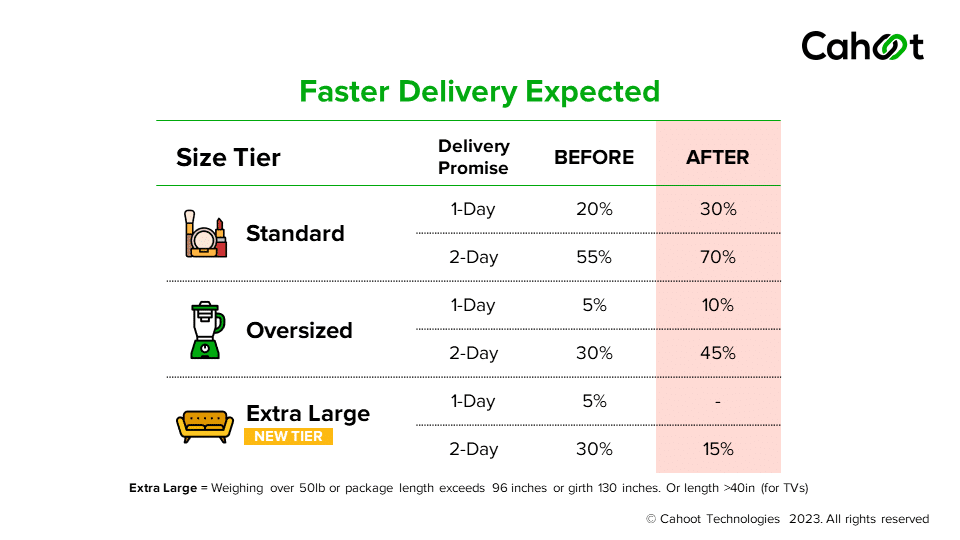
In its latest round of revisions to the program criteria, Amazon has increased the percentage of product detail page views that must promise 1 calendar day and 2 calendar day delivery. Thirty-percent (30%) of product detail page views for standard sized products must promise 1-day delivery, while 70% must promise 2-day delivery. But when does your listing promise 1-day delivery, and when does it promise 2-day delivery? Let’s understand this with a few examples:
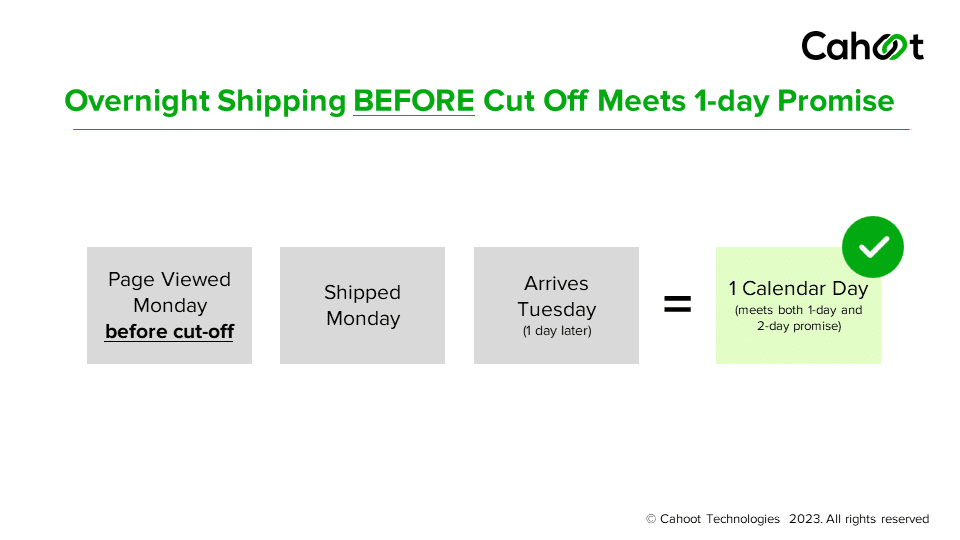
Let’s imagine every order is delivered the very next day after it ships. If a customer views your order on a Monday and places their order before the cutoff time, you will ship it that same day, and it reaches the customer the next day. In this case, Amazon displays a 1-day delivery promise and this page view counts towards your 1-day metrics.
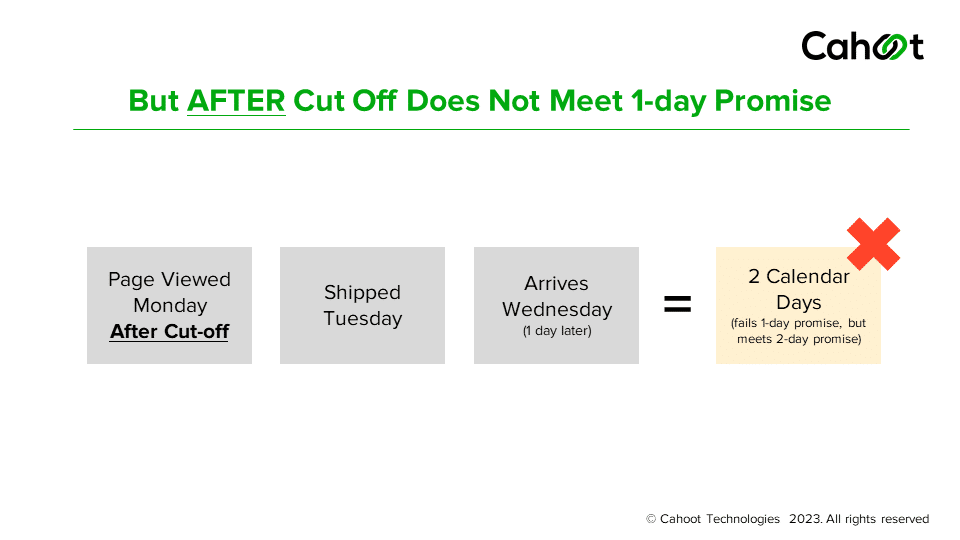
In this second case, when a customer looks at the product detail page after the cutoff time, you ship the order the next day after it is placed, and it reaches the customer the following day. This therefore fails to meet the 1-day promise, but meets the 2-day delivery promise (which means that if a 2-day promise was made after Monday’s order cutoff time, one-day shipping still needs to be used to deliver it in 2 calendar days).
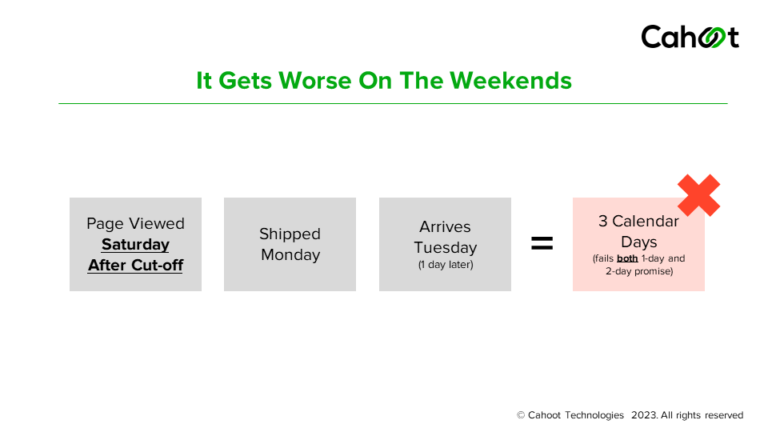
In this last case, it gets really bad. If a customer views your listing on a Saturday evening, the item is expected to ship on Monday (assuming you don’t ship Sundays) and it will be delivered to them on Tuesday – a full 3 days later.
In this case, such a page view counts toward neither the 1-day nor 2-day metrics. The implication is clear – your listings will display 2-day and even 3-day delivery promises for significant periods of time. The mapping between the number of warehouses you have, the percentage of the US population you can service with 1-day delivery, and the % page views that actually promise 1-day delivery is not linear. This graphic illustrates that:
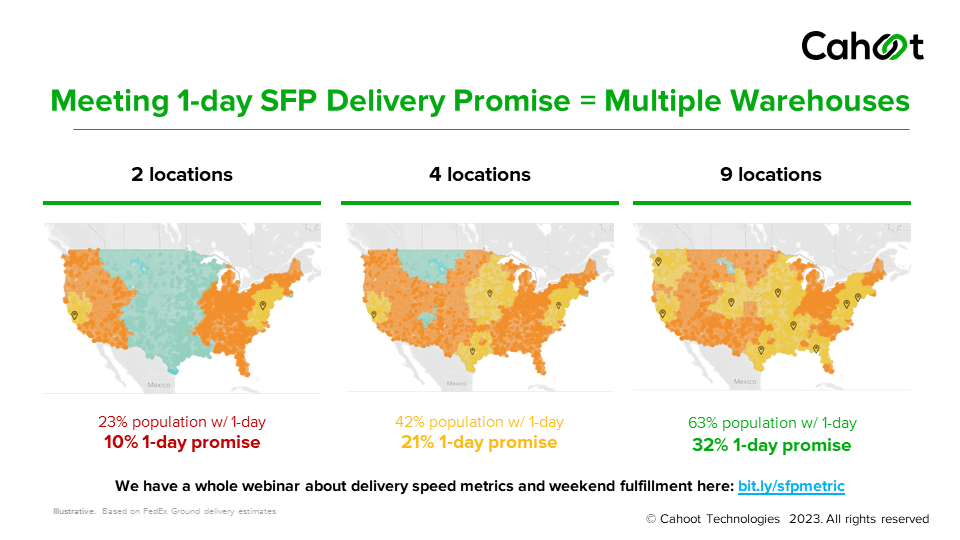
If you have warehouse locations, you can cover 42% of the US population with 1-day delivery. But different customers look at your product detail pages at different times of the day, and see different delivery speed promises. As per our research, in reality, only 21% of page views may actually promise 1 calendar day delivery. To meet the new Seller Fulfilled Prime delivery requirements, it could take as many as six to nine strategically located warehouses. These demanding metrics mean that traditional 3PLs will find it nearly impossible to help Seller Fulfilled Prime merchants (learn more about why traditional 3PLs are failing, and how peer-to-peer order fulfillment networks are designed to help you find success on SFP here). It becomes crucial for merchants to partner with order fulfillment networks that have warehouses at different strategic locations across the country, ensuring customers from anywhere see fast delivery promises. While merchants may want to upgrade to a fulfillment partner who is better positioned to meet these requirements, it’s easier said than done to leave your current 3PL for better alternatives. Many merchants don’t know how to evaluate and find the perfect fulfillment partner for them. If you’re looking for a step-by-step guide on migrating fulfillment partners, check out our guide here!
The Juggling Act Between Cut-off Times, Economical Shipping, and Meeting SLAs
With Seller Fulfilled Prime, a late cut-off time can potentially increase the number of orders your carrier picks up the same day, boosting your 1 and 2-day delivery metrics. If FBA faces any issues or does not meet the delivery promise shown to the customer on the product listing, there are no penalties for Amazon – but a Seller must meet the 93.5% on-time delivery criteria. Here’s a graphic demonstrating how delivery timelines look like when operating with a 2 PM cutoff time (based on our discussion of the page views metric):
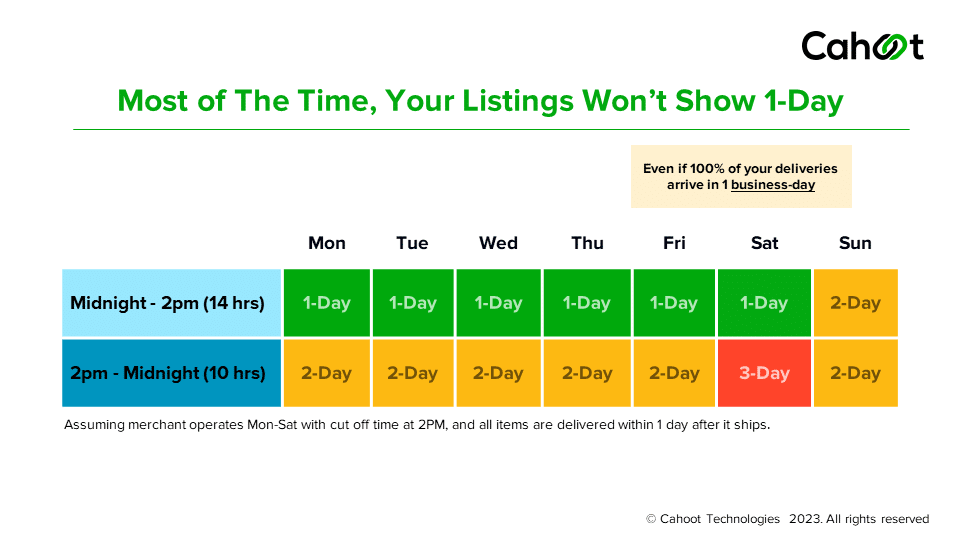
Sellers must carefully make the tradeoff between increasing their cutoff times (if they can schedule a late pickup with their carriers) versus also ensuring that those orders reach the customer the next day. Increasing the cutoff times increases the percentage of page views that promise 1 and 2-day delivery, but you must ensure that you can actually get the product to the customer’s doorstep within the time you’re promising. Here also, Sellers need to strategically place their inventory in a network of warehouses to avoid shipping orders placed close to cut-off times through expensive overnight air shipments. Placing inventory in different strategically located warehouses will enable nationwide coverage through economical ground shipping, all while meeting the customer’s expectations. Pay attention to time zones. A 2PM cutoff time is specific to the local time zone, so an order received before 5PM Eastern Time may need to ship from a western time zone to deliver on time, depending on the delivery promise. This makes it essential that your promotional activities (advertising, marketing) also closely follows the local time zones of the eyeballs you’re trying to reach. But it’s all very doable and Cahoot offers SFP consulting services to help. Reach out if you’d like to talk.
The shift to calendar days has had the most significant impact on the operational side of things – Sellers now have to plan a whole different way of running their business and schedules, which have also become challenges:
Operational Excellence Needed
Challenging to Staff And Operate Warehouses on Weekends
As we’ve mentioned before, staffing is often the biggest bottleneck towards finding success with order fulfillment. With weekend pick up and delivery expected to meet the calendar day-based SLAs, most merchants with a single warehouse or those working with 3PLs face difficulties succeeding in the program. If you own and operate your warehouses, paying your staff to work on the weekends or hiring additional people may eat into your margins to unfeasible extents. Traditional 3PLs, which are asset-heavy, also face cost pressures around labor – which they may be forced to pass onto Sellers. While these options erode any cost savings that Sellers see over FBA, you are not without alternatives – consider platforms like Cahoot, where each of our fulfillment centers is vetted for operational excellence and meets all the challenging requirements.
Arranging for Carrier Pickups on Weekends

In addition to warehousing, your carriers are another critical element in making your logistics work. Not all carriers offer weekend pick up and delivery – some may require you to be a large shipper and maintain minimum order volumes. All this means you may have to contact your account manager at the various carriers and enquire about possible options that may incur additional fees. However, while all this can be done, the biggest reason Sellers shy away from SFP is the heavy amount of process management, collaboration, and busy work needed to keep this operation running.
Managing Weekend Operations Can Overwhelm Sellers
It becomes easier to understand why so many Sellers shy away from Seller Fulfilled Prime – between working with multiple 3PLs to ensure your inventory covers the country, to operating and staffing your warehouses on the weekend as well as coordinating with your shipping carriers to arrange for weekend pickups, it can seem incredibly overwhelming and drain your bandwidth, time, and resources. You might often wonder whether managing so many stakeholders and sifting through so much busy work is worth it when FBA offers you only one party to work with – even if that party is Amazon, whose interests often tend to be misaligned with yours. It does not have to be this way – Sellers must spend time identifying partners who provide a unified experience where they get to work with just one vendor. Platforms like Cahoot help Sellers meet and exceed the SFP program requirement while ensuring you deal with only one company rather than coordinating between multiple 3PLs and carriers, preserving precious time and resources for you and your business.
Unnecessary Surcharges From Amazon Buy Shipping
In its latest round of revisions, Amazon no longer mandates the use of its Buy Shipping platform to print shipping labels. This is a major relief for Sellers, because Amazon Buy Shipping comes with one major issue that they have reported anecdotally – the platform is not great at estimating the delivery timelines for USPS services (the comment below from Amazon’s Seller Central forums highlights the issue):

In many situations, Buy Shipping does not accurately estimate the delivery timeline within which a USPS service can make orders. In such cases, Sellers are faced with a choice to pick from two bad alternatives: fail to show the customer a fast delivery promise (not an option for SFP Sellers) or buy a more expensive label from the choices that Buy Shipping does believe are capable of meeting the SLA:

This can be tough for Sellers to swallow – as order volumes increase, the extra costs paid on each shipping label begin to mount, eroding margins and profitability. Thankfully, Amazon no longer requires the mandatory use of the service. However, this does not automatically mean that you will see increased savings. You still need to make sure that you’re picking the most economical label on every order! This requires technology like Cahoot’s next generation shipping software, which intelligently rate shops across all carriers and shipping services from all available warehouse locations to always print the cheapest label that will meet the delivery date promised to the customer.
So while a lot can potentially go wrong, Sellers can also make the program work for them and find success by following specific, vital strategies. Start finding success in the SFP program by using the tricks and recommendations in our SFP Cheat Sheet!
“Cahoot is a game-changer. Their fully automatic shipping label creation intelligently assigns the best carrier and shipping service for all my orders across all my channels.”
~ LoveOurPrices.com
Speak to a fulfillment expert
The Cheat Sheet for Winning at Seller Fulfilled Prime
To enable Prime shipping, sellers must adjust their shipping templates and make specific selections in Seller Central and add all the warehouse addresses orders will ship from to support delivery regions for Prime service.
- Achieve Nationwide Coverage With a Warehouse Network: Making orders nationwide in under two days is no easy task. You need to distribute inventory strategically in at least 6 different locations to cover 97%+ of the country in this window. Operating from a single warehouse or one or two 3PL fulfillment centers will simply not cut it – you need to distribute your products across a network to meet the program requirements economically.
- Use Data to Guide Inventory Placement And Avoid Air Shipping: Even with a network model, it is crucial to analyze where most of your orders are coming from – placing your inventory close to those “order hubs” becomes a vital part of ensuring you will meet and exceed the one and two-day delivery requirements. This also ensures that you can reach all of your customers through economical ground shipping rather than being forced to make too many expensive air shipments.
- Consolidate Relationships And Eliminate Busywork: SFP can lead you down the rabbit hole of investing in multiple 3PLs and coordinating with numerous carriers to make the program work for you. Sellers need to conduct research and identify a platform that provides a single relationship for you to manage – otherwise, logistics can overtake your focus on the activities that matter – selling and taking care of your customers.
- Save Every Dollar Across Every Shipment: The whole point of moving away from FBA towards a program like SFP is to extract cost savings. It is essential to align your technology towards automation, whereby you’re automatically generating the lowest price shipping labels on every single order.
- Monitor Metrics Like a Hawk: Amazon provides you with dashboards on Seller Central that provide all the SFP metrics needed. It is crucial to constantly stay on top of these and keep adjusting your strategy to ensure you’re meeting expectations.
Succeeding in this program is challenging, but we think these tips are a great place to start. As Q4 and the holiday season approach, now is the time for Sellers looking to diversify their order fulfillment beyond FBA and offer fast, profitable free shipping across every SKU to identify a partner who can help you win at Amazon Seller Fulfilled Prime. If you’d like to understand how Cahoot can be with you every step of the way, just fill out this form, and we’ll be in touch!
Frequently Asked Questions
What is Seller Fulfilled Prime on Amazon?
Seller Fulfilled Prime allows you to list your products as Prime-eligible and handle the fulfillment yourself.
What is the difference between seller-fulfilled and Amazon fulfilled?
Logistics. Within the framework of Fulfillment by Amazon (FBA), the platform handles the entire logistics process – from product storage in warehouses to dispatching. Seller Fulfilled Prime (SFP) leaves you 100% in charge of everything in this regard, yet forces you to cover dispatch fees at your own cost.
How do you pre qualify for the Seller Fulfilled Prime trial?
To pre-qualify for the Seller Fulfilled Prime trial you must meet the following criteria over the past 90 days: Self-fulfilled at least 100 packages, Cancellation rate less than 2.5%, Valid tracking rate greater than 95%.
What is the difference between SFP and FBA?
FBA offers scalability and customer trust but comes with higher costs and limited control. FBM provides cost savings and customization options but requires more time and effort. SFP combines Prime eligibility with control over costs but has stricter requirements and operational challenges.
Is Seller Fulfilled Prime worth it?
In reality, it’s more of a trade-off. Seller fulfilled Prime offers the advantage of the Prime Badge and lower fees than FBA, but Amazon also levies stricter, potentially more costly requirements than FBM. But SFP orders can command higher prices (15 – 20%) and allow for more control. With a well-managed program, it can be quite beneficial.
Up to 64% Lower Returns Processing Cost
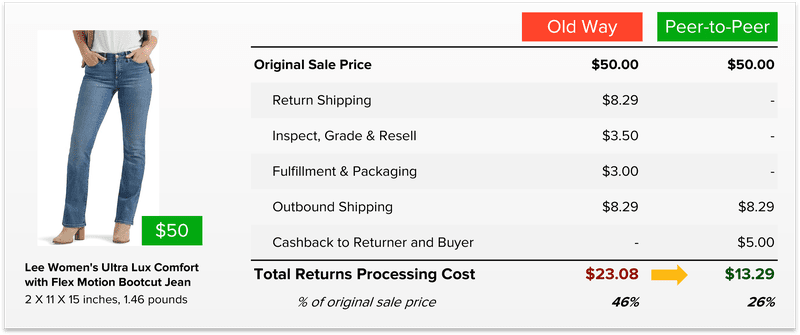
Top 8 Amazon 3PL Shipping Companies for Reliable Fulfillment
In this article
 12 minutes
12 minutes
- Key Takeaways
- Cahoot: Leading Amazon Fulfillment Partner
- ShipBob: Well-Rounded
- Red Stag Fulfillment: Precision and Reliability
- ShipMonk: Full-Service Fulfillment Solutions
- ShipNetwork: Flexible Logistics Options
- Shipfusion: Tech-Driven Fulfillment Services
- MyFBAPrep: Enterprise-Level Fulfillment
- AMZ Prep: Comprehensive Fulfillment Solutions
- Choosing the Right 3PL Provider for Your Amazon Business
- The Role of Technology in Modern 3PL Services
- Benefits of Using Third-Party Logistics for Amazon Sellers
- How 3PL Providers Enhance Customer Experience
- Cost Management with 3PL Services
- Ensuring Data Security and Privacy with 3PLs
- Summary
- Frequently Asked Questions
If you’re an Amazon seller looking to improve your logistics, whether by fully outsourcing fulfillment or keeping some of it in-house, finding the right 3PL provider is essential. This article reviews the top 8 Amazon 3PL shipping companies. You’ll learn about providers that offer faster shipping, reduced costs, and specialized services to meet your fulfillment needs.
Key Takeaways
- Cahoot’s peer-to-peer order fulfillment model allows for faster and more cost-effective logistics, making it ideal for small businesses competing with larger retailers.
- Advanced technology plays a crucial role in optimizing 3PL services, enhancing order accuracy and efficiency while allowing for real-time tracking and management.
- Partnering with a 3PL provider offers significant cost management benefits, as businesses can convert fixed costs to scalable expenses and access transparent pricing models.
Cahoot: Leading Amazon Fulfillment Partner
Cahoot stands out with its innovative peer-to-peer order fulfillment model that leverages merchant-operated warehouses. This approach not only offers faster and more cost-effective fulfillment compared to traditional 3PLs but also allows businesses to tap into unused space at merchant warehouses across the country. This unique model enables Cahoot to provide ultrafast order fulfillment services, making it a game-changer for ecommerce companies. And Cahoot has demonstrated that fulfillment accuracy is unmatched when Sellers fulfill for other Sellers because they care, they “get it”, they understand the complexities and importance of performance metrics and how they impact the livelihoods of online businesses.
Small businesses benefit from Cahoot’s scalable logistics support, allowing them to compete with larger retailers. The platform integrates seamlessly with major ecommerce marketplaces and shopping carts such as Amazon, eBay, Shopify, and BigCommerce, making order fulfillment more efficient. Cahoot also provides nationwide 1-day and 2-day shipping through its network of over 100 fulfillment centers, enabling merchants to meet high consumer expectations.
Furthermore, Cahoot’s participation in Amazon’s Seller Fulfilled Prime (SFP) Program sets it apart. Partnering with Cahoot allows merchants to meet Amazon’s stringent SFP requirements, such as same-day fulfillment and weekend shipping. The advanced fulfillment technology and software provided by Cahoot enhance order accuracy, provide real-time visibility, and reduce operational costs, ensuring a smoother and more efficient fulfillment process. And with Cahoot, merchants can participate as a fulfillment warehouse from their own location, adding and removing Cahoot locations as needs change; not the case with any other 3PL.
Cahoot also supports all the expected additional services such as FBA prep, inventory barcoding and bundling, B2B fulfillment, returns management, and distribution services, among others. With exceptional customer support ratings and awards and hundreds of 5-star reviews across all the major customer confidence sites like G2, Google, Trustpilot, even Shopify and Amazon app stores, Cahoot is one of the leaders in warehousing and streamlined fulfillment services.
ShipBob: Well-Rounded
ShipBob is a solid choice for Amazon fulfillment, providing a range of services tailored for Amazon Sellers. They offer FBA prep services, which help businesses navigate Amazon’s specific requirements. Their pricing model is flexible enough to accommodate the diverse needs of Amazon businesses.
ShipBob employs advanced technology to support efficient order fulfillment and inventory management, making logistics operations straightforward. Their customer service is accessible through phone, email, and chat, providing support for logistical needs.
Overall, ShipBob is a dependable fulfillment partner for Amazon Sellers, focusing on customer satisfaction and operational efficiency without overpromising. They offer reliable services that can help streamline your logistics processes.
Red Stag Fulfillment: Precision and Reliability
Red Stag Fulfillment is a reputable choice known for its dedication to delivering precise and reliable order fulfillment, warehousing, and shipping solutions. Their pricing structure is designed to be straightforward, ensuring clients only pay for the services they actually use, which makes it a sensible option for businesses conscious of costs. While their promise of 100% order accuracy and zero loss or damage is commendable, it’s important to remember that no system is entirely foolproof.
A notable aspect of Red Stag Fulfillment is their capability to handle bulky or oversized items, which can be a significant advantage for businesses with unique logistical challenges. They offer a supportive onboarding process, helping new clients transition smoothly and establishing a fulfillment process that aligns with their specific needs.
Red Stag Fulfillment’s emphasis on precision and reliability contributes to a positive customer experience and helps streamline the fulfillment process at their centers. While they set high standards in logistics, businesses should evaluate whether their specific offerings align with their unique requirements and expectations.
ShipMonk: Full-Service Fulfillment Solutions
ShipMonk brings a variety of fulfillment services to the table, including order fulfillment, FBA prep services, and support for the Seller Fulfilled Prime program. Their pricing model is designed with Amazon Sellers in mind, aiming to provide cost-effective solutions that align with business operations.
A notable feature of ShipMonk is its swift order processing. This efficiency helps in getting orders to customers promptly, which can enhance the shopping experience. This efficiency, combined with its comprehensive fulfillment solutions, makes ShipMonk a formidable partner for ecommerce businesses looking to streamline their logistics operations.
ShipNetwork: Flexible Logistics Options
ShipNetwork offers logistics options that are adaptable to the specific needs of Amazon Sellers. Their services, which include inventory management and order shipment, are a good choice for maintaining smooth logistics and fulfillment operations. They provide customer support through various channels like phone, email, and online case submission, which can be handy when you need assistance.
One of ShipNetwork’s interesting offerings is their customized packaging solutions. These can help maintain brand identity during fulfillment, adding a personalized touch to orders. With such flexible and customer-focused services, ShipNetwork stands out as a versatile logistics partner.
Shipfusion: Tech-Driven Fulfillment Services
Shipfusion is a tech-oriented 3PL provider offering end-to-end fulfillment services, mainly for high-volume ecommerce and wholesale businesses. With locations in Chicago, Los Angeles, Las Vegas, and Toronto, they provide specialized storage solutions, including temperature-controlled and cold-chain shipping, to accommodate diverse product needs. Shipfusion’s software allows for real-time tracking and management, adding a layer of control over fulfillment operations. This technology-driven approach ensures efficient and reliable operations in order fulfillment.
MyFBAPrep: Enterprise-Level Fulfillment
MyFBAPrep caters to large brands with its enterprise-level logistics services. Their extensive network of warehouses facilitates efficient distribution, aiming to position inventory for quick delivery. This setup can help reduce shipping times and costs, a crucial factor in maintaining strong margins.
Their integration with Amazon’s FBA program is a plus, as it allows Sellers to leverage Amazon’s extensive fulfillment network while maintaining control over their inventory and logistics processes through an FBA prep service and consolidated inventory visibility.
AMZ Prep: Comprehensive Fulfillment Solutions
AMZ Prep is a tech-enabled 3PL provider offering services like inventory management, warehousing, order processing, and shipping. Their solutions are crafted to be efficient and affordable while providing comprehensive solutions that cater to the diverse needs of ecommerce businesses. Their reliability makes them a valuable partner for brands aiming to optimize logistics strategies.
Choosing the Right 3PL Provider for Your Amazon Business
Selecting the right 3PL provider is a critical decision for any Amazon business. Choosing a provider with a long-term vision is crucial for overcoming current logistics challenges and preparing for future growth. Ecommerce companies should begin by analyzing their reasons for needing a 3PL, such as operational challenges or business structure changes.
Cost-efficiency plays a significant role in this decision. Businesses should seek providers offering efficient operations without hidden fees that could inflate costs. Evaluating the global reach of a 3PL is also important for powering international expansion, making advanced technology a central consideration. Providers using state-of-the-art technology can optimize logistics operations through automation, offering scalable solutions that grow with your business. This blend of cost-efficiency, global reach, and advanced technology will ensure that your chosen 3PL provider can meet your evolving needs.
The Role of Technology in Modern 3PL Services
In the modern 3PL, technology plays a pivotal role in 3PL services. Quality 3PL providers invest in advanced technology systems, and the best are proprietary warehouse management systems (WMS) and transportation management systems (TMS), that improve their competitive edge. These systems enhance order accuracy, optimize resource use, and reduce operational costs through automation and data capabilities. The savings get passed onto their clients.
Cloud-based WMS integrates with existing technologies, offering comprehensive visibility across the supply chain. This integration enables real-time data tracking, minimizes errors, and accelerates processes, allowing teams to focus on core tasks. Employing technology for warehousing and inventory management helps businesses reduce overstocking and related costs, boosting overall efficiency.
AI and ML are transforming 3PL operations by enabling smarter inventory management and route optimization. These technologies allow for predictive analytics, helping businesses anticipate demand and streamline their logistics operations. Technology’s role in 3PL services drives efficiency and innovation in the industry.
Benefits of Using Third-Party Logistics for Amazon Sellers
Collaborating with a third-party logistics provider offers numerous benefits for Amazon Sellers. Optimizing logistics operations leads to significant cost savings and improved customer service. Cahoot and ShipBob, for instance, use a nationwide network of fulfillment centers to minimize shipping times and costs, creating an exceptional customer experience.
Quick preparation times are another advantage, with some providers ensuring items are ready for fulfillment within 24 to 72 hours, and more modern solutions providing same-day fulfillment late into the day. This speed is crucial in supporting high customer satisfaction and loyalty. Likewise, automation in the picking, packing, and shipping workflow improves delivery speed and accuracy.
3PL providers also offer specialized services like kitting, subscription box fulfillment, and comprehensive returns management. These value-added services enable businesses to focus on core competencies while the 3PL manages logistics complexities, making them indispensable to ecommerce Sellers.
How 3PL Providers Enhance Customer Experience
Enhancing customer experience is a primary goal for any ecommerce business, and 3PL providers play a crucial role in achieving this. Reliable logistics providers can achieve on-time delivery rates above 97%, significantly improving customer trust and satisfaction. High order accuracy rates of 99.9%+ ensure customers receive exactly what they ordered, reducing returns and complaints.
Personalized and dedicated support from account specialists enhances customer service, making it easier to resolve issues efficiently. Effective returns management simplifies the process for customers, encouraging repeat business and loyalty. Real-time tracking and automated notifications keep customers informed about their order status, enhancing their overall shopping experience.
3PL providers also offer customized fulfillment service options, including a variety of shipping methods, ensuring that customer expectations are not just met but exceeded. By focusing on these elements, 3PL providers don’t just improve customer satisfaction – they build lasting relationships that turn shoppers into loyal fans.
Cost Management with 3PL Services
Running a successful Amazon business means keeping a keen eye on costs, and partnering with a 3PL provider can be a game-changer in this area. These providers offer a flexible cost model, allowing you to pay only for the services and space you actually use. This means you can turn fixed costs into scalable expenses, giving you the agility to adapt to changing demands effortlessly.
When it comes to shipping, negotiating costs with your 3PL can lead to significant savings, as shipping often takes a big bite out of your logistics budget. Ask for discounts on inbound container shipping, and make sure there are no hidden fees lurking in the shadows, allowing you to plan your budget with confidence.
Regular performance reviews with your 3PL ensure they are hitting those efficiency and cost-saving targets. Plus, consolidating orders into fewer shipments can further lower your shipping costs. By leveraging these cost management strategies, you can optimize your logistics operations and boost your financial performance.
Ensuring Data Security and Privacy with 3PLs
Data security and privacy are paramount when working with third-party logistics providers. Defining clear data access limits and implementing robust security measures is vital when negotiating 3PL contracts to protect sensitive information. Contract clauses should specify data ownership, access rights, and security measures such as encryption and incident response protocols.
Regular audits and compliance checks ensure 3PL providers adhere to agreed-upon data security practices. Cahoot, for instance, protects consumer data by ensuring that fulfillment partners only see the minimum information required to fulfill orders, unlike traditional logistics companies.
By prioritizing data security and privacy, businesses can maintain customer trust and protect their valuable information.
Summary
Navigating the world of third-party logistics can be challenging, but selecting the right 3PL provider is essential for the success of your business. From Cahoot’s innovative and high-quality peer-to-peer model to ShipBob’s comprehensive fulfillment services and Red Stag Fulfillment’s precision and reliability, each provider offers unique benefits tailored to different business needs. By understanding the specific strengths and offerings of these top 3PL companies, you can make informed decisions that enhance your logistics operations and drive growth.
Remember, the right 3PL provider not only streamlines your fulfillment process but also significantly impacts customer satisfaction and cost management. Partnering with a reliable and technologically advanced 3PL will be essential to staying competitive and meeting the ever-growing expectations of your customers.
Frequently Asked Questions
What are the benefits of using Cahoot for Amazon fulfillment?
Using Cahoot for Amazon fulfillment provides a cost-effective and reliable solution through its peer-to-peer model, enabling low-cost 1-day and 2-day shipping nationwide, as well as easy integration with major ecommerce platforms and access to Amazon’s Seller Fulfilled Prime program. This positions your business for optimal efficiency and exceptional customer satisfaction.
How does ShipBob support Amazon Sellers?
ShipBob supports Amazon Sellers by offering fulfillment services such as FBA prep, advanced technology for efficient order processing, and dedicated customer support, all aimed at enhancing the logistics experience.
What makes Red Stag Fulfillment unique?
Red Stag Fulfillment stands out due to its expertise in managing bulky or oversized items, its commitment to 100% order accuracy with no shrinkage, and the dedicated onboarding support it provides, catering effectively to businesses with specific logistical demands.
How does technology enhance 3PL services?
Technology significantly enhances 3PL services by improving order accuracy, optimizing resource utilization, and reducing operational costs. Utilizing advanced systems such as WMS and TMS, alongside AI and machine learning, facilitates real-time data tracking and smarter inventory management.
What should businesses consider when choosing a 3PL provider?
When choosing a 3PL provider, businesses must prioritize the provider’s long-term vision, cost-efficiency, global reach, advanced technology, and scalable solutions. These factors are essential for meeting evolving logistics needs effectively.

Up to 64% Lower Returns Processing Cost

How To Offer Free Shipping on Your Ecommerce Store & Still Make a Profit
In this article
 3 minutes
3 minutes
- Top 12 Shipping Strategies For Making Free Shipping Profitable
- Top 5 Pricing Strategies For Making Free Shipping Profitable
- Top 8 Marketing Strategies For Making Free Shipping Profitable
- Top 7 Supply Chain Strategies For Making Free Shipping Profitable
- Top 7 Returns Optimization Strategies For Making Free Shipping Profitable
For any online Seller wanting to get ahead of the pack, offering fast and free shipping is a must. But shipping is not really free, is it? And it can creep into your margins. We have created THE ultimate guide on how to offer free shipping and still make a profit. Keep reading to learn nearly 40 proven ways you can offer free shipping profitably and radically improve your bottom line.
Top 12 Shipping Strategies For Making Free Shipping Profitable
Free shipping has evolved from a bonus perk to an expectation among online shoppers. But for businesses, it presents a major challenge—how do you cover shipping costs without eating into your profit margins? The answer lies in smart logistics and strategic planning. By negotiating better rates, optimizing fulfillment processes, and leveraging hybrid shipping solutions, you can offer free shipping while still protecting your bottom line. This guide explores strategic shipping best practices for turning free shipping from a costly obligation into a competitive advantage, ensuring both customer satisfaction and long-term business sustainability.
Read more.
Top 5 Pricing Strategies For Making Free Shipping Profitable
Pricing plays a critical role in both conversion rates and profitability, and when it comes to free shipping, it’s essential to strike the right balance. Simply absorbing shipping costs without adjusting your pricing model can lead to financial strain. Instead, businesses need to strategically incorporate shipping expenses into their pricing structure—whether through slight price adjustments, minimum order thresholds, or dynamic pricing models. This article breaks down five proven pricing strategies that help businesses recover shipping costs while remaining competitive, ensuring that free shipping enhances rather than erodes profitability.
Read more.
Top 8 Marketing Strategies For Making Free Shipping Profitable
Free shipping is a powerful marketing tool that can boost conversions, build customer loyalty, and increase average order value. However, if not executed strategically, it can also lead to shrinking margins. The key is to use free shipping as a lever to drive sales, whether through limited-time promotions, loyalty programs, or strategic bundling. This article explores eight marketing strategies that not only make free shipping sustainable but also turn it into a growth engine for your business. If you’re looking for ways to attract customers and keep them coming back without compromising profitability, this is the guide for you.
Read more.
Top 7 Supply Chain Strategies For Making Free Shipping Profitable
Behind every successful free shipping program is a well-optimized supply chain. Whether it’s managing inventory more efficiently, leveraging regional fulfillment centers, or adopting dropshipping as part of your operating model, businesses that refine their logistics can reduce costs and make free shipping a feasible, profitable option. This guide takes a deep dive into seven key supply chain strategies that help ecommerce sellers minimize expenses while still offering fast and affordable shipping. If you want to turn free shipping from a financial drain into a business advantage, these supply chain optimizations are a must-read.
Read more.
Top 7 Returns Optimization Strategies For Making Free Shipping Profitable
Returns are a natural part of ecommerce, but without the right strategy, they can quickly become a financial burden. The good news is that returns optimization can help businesses reduce unnecessary refunds, streamline reverse logistics, and even recover revenue. Whether it’s improving product descriptions to prevent returns, offering in-store drop-offs, or leveraging ecommerce programs, this guide outlines seven actionable strategies that make free shipping sustainable by keeping your returns program cost-effective. If returns are eating into your margins, these strategies will help you regain control.
Read more.

Up to 64% Lower Returns Processing Cost

Top 5 Pricing Strategies For Making Free Shipping Profitable
Pricing is one of the most determining factors of a customer’s buying decision. While customers naturally gravitate towards the lowest price, this expectation is now the norm thanks to marketplaces placing a high importance on low final prices (which includes the list price and shipping cost). If you look at any product page in Amazon, very likely the Seller who has the Buy Box also has the cheapest offer. This price expectation puts pressure on online Sellers to set a “just right” price that is both low, but low enough to cover free shipping. As a result the cost of shipping is an important component of online product pricing.
In this article, we will talk about five ways to recover your shipping costs using strategic pricing strategies:
1. Include Shipping Costs in Product Prices
Remember the last time you were irritated about hidden resort fees during hotel checkout? Or that mysterious additional tax you didn’t know about when traveling to a new city? Similarly, customers perceive a surprise shipping charge negatively, which might lead to cart abandonment.
However, the shipping cost is an inseparable part of selling online. There should be no reason to treat this cost separately. What if you included the shipping cost in the price of the item?
Imagine having to pick between these two options for something you’re about to buy:
- Option 1: $30 + $5 shipping charge
- Option 2: $35 with free shipping
Bill DAlessandro, from consulting firm Rebel CEO, ran this very test for a skincare product and found that including shipping in the product cost (Option 2) converted twice as many shopping carts. Several other studies have shown that customers are more likely to abandon the shopping cart when they see a shipping charge added during checkout, the top reason by more than 2-fold!
How do you distribute shipping costs to individual item prices? One approach is to change the pricing of items below your free shipping threshold to include a portion of the expected shipping cost.
Say a merchant offers free shipping for orders of $50 or more, and the average shipping cost is $5. Start by converting your sale price to a percentage of the free shipping threshold, and then add that percentage of the average shipping cost to the item price. For example, a $25 item is 50% of the $50 free shipping threshold, so add 50% of the shipping cost to the item price ($2.50), for a new sale price of $27.50. Similarly, a $10 item is 20% of the $50 free shipping threshold, so add 20% of the shipping cost to the item price ($1.00), for a new sale price of $11.00.
The advantages of including shipping costs in the product price are:
There are other factors that you might want to keep in mind before using this method:
2. Offer Free Shipping on Select Items Only
It is tough to offer free shipping for your entire product catalog when you sell everything under the sun, big or small. But you can thoughtfully select which items to offer with free shipping.
It is often the items with low-margins, heavy-weight, and big-size that suffer losses from shipping costs. This should not stop you from providing your customer with free shipping on higher-margin items where the shipping cost is not a big chunk of the product price.
The key is communicating it effectively to the customer. Being clear and upfront about such restrictions will help customers navigate your page easily and with trust. Here’s an example that Neil Patel demonstrates in this blog where the Seller offers free shipping on all footwear SKUs:

Source: https://neilpatel.com/blog/make-free-shipping-profitable/
A more subtle way to offering free shipping on specific products is setting a free shipping threshold that meets exactly the item you plan to offer free shipping. For example, if your website sells shoes starting at $75 and socks starting at $12; setting free shipping at $75 allows you to offer free shipping to anyone who buy at least 1 pair of shoes, but will only offer free shipping if someone orders 7 pairs of only $12 socks.
He goes on to show how there is a marked improvement in net profits with this experiment despite a reduction in margin per SKU. The increase in sales yields more revenue and higher overall profitability.
Offering free shipping on a limited SKU selection has its benefits:
Keep in mind these few things while implementing this shipping strategy:
3. Enable Free Shipping on Large Orders
Setting a minimum order value to unlock free shipping increases your revenue, creating the margin needed to recover your shipping costs. But this shipping strategy does not work for everyone.
Publishing a minimum order value encourages customers to target a particular shopping cart subtotal such as $50. But if you have a limited product catalog, the customer may abandon the purchase because they cannot find additional relevant items to purchase. In this case, it may be easier to nudge them with a prompt that says, “free shipping when you buy 3 or more”, targeting an order quantity rather than an order subtotal. It may sound silly, but not all customers would think of increasing the item quantity to achieve the free shipping threshold.
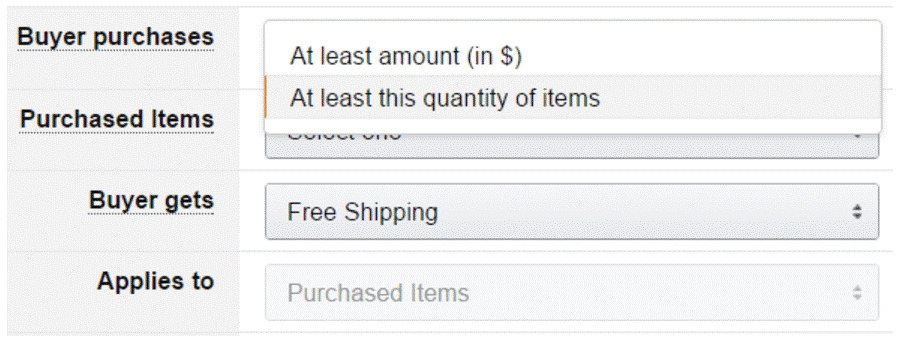
It works best for consumables that customers regularly buy, like personal care or household items. For these products, customers are used to expecting savings when buying in bulk. The end goal is similar to the minimum order value in that the merchant can increase the average order value and ship the items together to decrease the shipping costs.
The advantages of bulk/quantity-based free shipping offers are:
A possible hindrance to something like this would be:
4. Introduce Flat Rate Shipping
If for some reason it is not possible to include shipping costs in your product prices, there is still a way to manage customer expectations. Customers will have less anxiety about shipping charges if they know the flat rate shipping cost upfront, regardless of how much they spend.
Online shoppers must take into account many factors when deciding on a purchase. Making the shipping cost clear and simple will make the shopping experience easier, and customers respect the transparency.
You should consider your average margin per unit and average shipping cost to calculate a profitable flat rate to charge. Here’s an example of an online Seller advertising flat rate shipping very effectively: “We don’t want our customers to experience sticker shock when they see the shipping rates at our store. Also, we want to make our online shopping experience straightforward and having a $10 Flat Rate Shipping charge lets customers quickly calculate their costs. That can’t be a bad thing, right?”
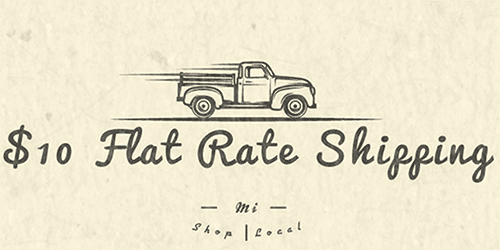
Source: https://www.giftbasketsfrommichigan.com/blog/gift-baskets/everyday-10-flat-rate-shipping
There are many flat rate services to choose from (size and weight restrictions apply):
- FedEx One Rate has several options for overnight and 2-day flat rate shipping, depending on what time of day the package needs to be delivered. Pricing depends on the size of the package (dimensions) and how far it’s traveling (there are 3 zones defined). FedEx offers free packaging included with each service, which is a nice perk to keep cost down.
- UPS Simple Rate has more flexible shipping speeds accommodating next day, 2-day, 3-day, and 5-day transit times that in both air and ground services. There are no zones defined by UPS, so one rate is truly one rate, and a packaging subsidy is available for UPS Digital Connections members.
- USPS Priority Mail Flat Rate delivers within 1 – 3 days, though it’s not guaranteed like FedEx and UPS flat rate services are, and only considers a single zone like UPS. Rates are cheaper when purchased using an online solution as compared to purchasing at a post office window, and Flat Rate boxes and mailers come in the widest variety of sizes and are free for shippers.
Some of the advantages of flat-rate shipping are:
You should be careful about the following:
5. Adopt a Dynamic Shipping Charge
Customers may sometimes find your competition is offering the same items at lower prices. But in some cases, your warehouse may be closer to the customer allowing you to ship faster and cheaper than the competition, creating the opportunity to leverage your proximity by offering a more attractive shipping option.
To adopt a dynamic shipping price strategy, ask the customer for their zip code during checkout and use it to determine your actual cost and transit time using real-time rate shopping across all your carriers and services.
Maybe you want to determine if free shipping should be offered or not. Perhaps it’s used as a surprise and the enchanted customer feels that they’ve won something, increasing conversion rates.
Typically ecommerce Sellers calculate shipping charges using the average shipping rate for all their sales, a combination of different zones, sizes, and weights. So, some customers pay more than they should for shipping while others pay less. If the shipping charge imposed on the customer is higher than other Sellers, because of the kind of item you ship (heavier, larger, for example), your cart abandonment rate will be higher.
By collecting the zip code, there is an opportunity to charge the customer the shipping fee tailored to them, encouraging them to buy from you. You can get real-time estimates of shipping rates right from your shipping solution or Order Management System (OMS) by connecting it to the checkout page. This approach also ensures that your shipping cost is covered, effectively taking it out of the equation.
This blog by Squarespace explains one way to do it in great detail, including how to add a markup to create a profit center from your exceptional negotiated rates.

Source: https://support.squarespace.com/hc/en-us/articles/213022907-Carrier-calculated-shipping
The big benefits of having this system are:
There are repercussions to imposing a dynamic shipping charge:
Summary
The reality of modern ecommerce is that free shipping is no longer a luxury, it’s an expectation. But it doesn’t have to be a burden on your bottom line. By integrating shipping costs into your pricing strategy, selectively offering free shipping, or using dynamic pricing models, you can create an approach that aligns with customer expectations while keeping your business financially healthy. The key is to experiment, track results, and adjust as necessary…what works for one business may not work for another. When done right, free shipping can become a powerful conversion tool that boosts sales, improves customer loyalty, and ultimately drives long-term profitability.
Download The Ultimate Guide to Profitable Free Shipping
Frequently Asked Questions
How to price for free shipping?
If the average shipping cost is $5 per order, that means you would lose $5 each time you provided free shipping. If, however, you increase product prices by 20% so the average product price is $10 or more, you can offset the cost of shipping on an average order.
Does offering free shipping increase sales?
Yes, offering free shipping can increase sales. Numerous studies show that free shipping is a key factor in purchasing decisions.
How do retailers afford free shipping?
Some merchants ask customers to cover shipping expense on smaller, lower margin orders. Shoppers are incented to buy more, since additional items ship for free. As the order size increases, overall gross margin goes up, covering the incremental shipping cost increase. Another option is to include shipping costs in product prices.
What is a good free shipping threshold?
Knowing how much an average customer spends per transaction can provide a better idea of what a business’ minimum order value for free shipping should be. A free shipping threshold should be slightly (about 30%) above the average order value to encourage customers to add more items to their cart.
How to offer free shipping without losing money?
The simplest way to make free shipping work for your shop is to price your items to include the shipping cost in the item list price. You can choose to offer free shipping to buyers only located in your country, or to all buyers around the world based on your shop’s needs and customer demographics.

Up to 64% Lower Returns Processing Cost

Top 7 Returns Optimization Strategies For Making Free Shipping Profitable
In this article
 15 minutes
15 minutes
- Eliminate the Root Cause(s) for Your Returns
- Offer Local In-Store Returns to Save on Shipping
- Use Consolidator Services for International Returns
- Restrict Returns from High-Risk Profiles or Categories
- Pre-create Return Shipping Labels
- Listen to Your Comprehensive Customer Feedback
- Add a Recommerce Program
- Summary
- Frequently Asked Questions
Offering free shipping to your customers can be a powerful driver of sales and a long-term retention mechanism, but what happens when customers start sending products back? Without an optimized returns strategy, reverse logistics can eat into your margins, making free shipping unsustainable. The good news is that businesses can take control of their returns process, turning it from a costly necessity into a manageable, or even profitable, part of their operation. From improving product descriptions to leveraging recommerce programs, this guide will walk you through seven key strategies to optimize returns and make free shipping a viable, long-term customer acquisition and retention strategy.
1. Eliminate the Root Cause(s) for Your Returns
Prevention is the best medicine. The best-case scenario is for customers to not have a reason to return something at all. There are three major preventable reasons why customers return a product: (1) the product doesn’t match their expectations when buying, (2) they don’t like the product right away but they still might in time, and (3) they bought the product by mistake.
Mismatched Expectations
What customers see on the product page needs to be precise. Product descriptions should be elaborate and always have a detailed specifications section, mainly because different customers value different features. Size charts and physical specifications (such as weight and dimensions), also help shoppers make the right choice the first time.
There is more than one way to populate a good product page, below is an example from Solo Stove:
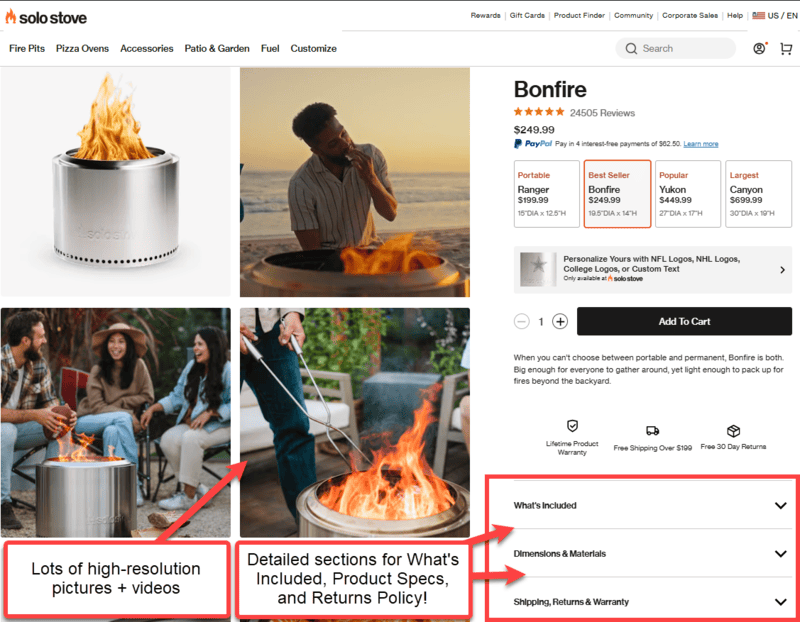
Visualization is important to convey the real product value. Add multiple photos from all relevant angles, and if possible, a video too. It’s a more realistic depiction of the product in action. With new developments in AR and VR, a few apps also allow customers to try their products virtually. Amazon’s virtual changing room allows you to use your phone camera in the mobile shopping app to try outfits on your virtual avatars. Warby Parker has used similar technology on their website so users can ‘see’ what they would look like in a pair of frames. Nespresso’s augmented reality solution enables users to ‘see’ what a new coffee machine would look like on their kitchen counter, rotating it in virtual space to adjust fit and orientation. Some third-party applications let customers try on products virtually across different online stores.
Having multiple helpful and fair reviews of your product is also essential. This adds to the transparency of your product’s limitations and will prevent customers from surprises. Having numerous honest reviews with photos adds to the credibility of your product. Although only a handful of customers are willing to leave reviews, it’s a worthwhile effort to ask for one.
Tools like Amazon’s Frequently Returned Item Badge may turn off a small percentage of customers and push them in a different direction, but when the cost of reverse logistics for a product is particularly high, preventing the return in the first place may be better than absorbing the painful cost later. Because different customers value different features and functionality, and because sizing charts can only provide so much guidance, knowing the reason for frequent returns may enable them to select the next larger size or a different color. This feature is similar to having high-quality reviews and helps customers spend the time reading through reviews to learn what other’s experiences with your products were.
Not Liking Something Right Away
Some products such as home decor may take some getting used to and you should try increasing the return window for these products. You would think that a larger return window would increase the number of returns, but it can actually have the opposite impact as it removes the pressure to return it as soon as possible. The longer the product stays with the customer, the more it can grow on them, something economists call the endowment effect.
Bought by Mistake
In the event of a mistake during check out, give customers the option to cancel their order within a short period of time after placing the order. This gives them the opportunity to reorder the correct item before fulfillment begins, preventing the inevitable return before it costs you money for all the logistics and reverse logistics. An example of this is accidentally purchasing the Solo Stove Lite which is a small tabletop item that fits in the palm of your hand, not a less heavy fire pit. Having high-quality descriptions, and pictures could prevent this, but giving customers enough time to correct the mistake could help prevent a future return.
It all boils down to having a killer product page. Building it is an interactive process, and it is important to understand why returns happen, so you can take the steps to improve the product page.
Having support available for customers to ask questions would also reduce preventable returns. Some products like furniture require some assembly, and sometimes customers get confused. At that peak frustration point, customers will then return the product. Having a customer service line (even if it’s with the manufacturer and not the Seller), can defuse the situation before returns happen.
2. Offer Local In-Store Returns to Save on Shipping
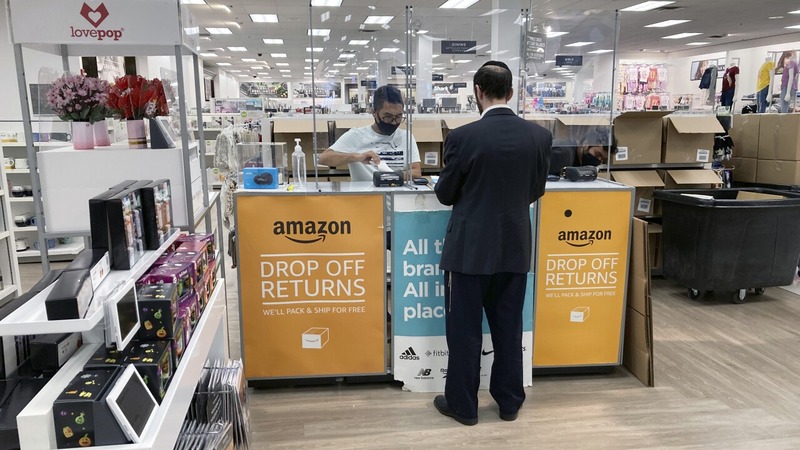
Now that you’ve finished dealing with the main reasons for product returns, it’s time to look into making returns more efficient and profitable. Offering returns to your retail store (or using an attended kiosk solution such as Happy Returns, Loop Returns, or Narvar) has several significant benefits:
- You (or the customer) won’t pay for return shipping.
- It prevents fraud because a human is accepting the return, even if it only gets a cursory inspection.
- It creates an opportunity to increase sales and makes up for restocking fees.
- Returning at a store or attended kiosk is easier for customers who dislike the hassle of repackaging and shipping the product back to the Seller because by nature, they are boxless and don’t require a printer to print a shipping label.
As long as customers don’t mind going to a store, it’s also faster for smaller issues such as a t-shirt size exchanges.
A UPS survey found that 70% of customers who returned an item at a physical store ended up buying something else during that trip. So even if a customer is not interested in the product anymore, there’s an opportunity to upsell other items in the store. You can also enhance that conversion with coupons offering discounts for customers coming for returns. For example, Kohl’s gives anyone returning Amazon products at its stores a coupon, anywhere from 25% off an item, to $5 flat discount. Staples offers 10% off to customers returning partner retailer items, good for 14 days.
3. Use Consolidator Services for International Returns
If you sell internationally, returns can be a massive logistical headache. Not only is it expensive and complicated with different carriers, but it also includes dealing with border customs. Moreover, if you are selling on marketplaces such as Amazon, you are required to offer local return addresses in countries you’re selling to and free return services.
However, international returns can be very pricy through carriers, forwarders, or FBA. Some solutions exclusively handle international returns such as InterCultural Elements, Salessupply, or ReBOUND. They consolidate product returns similar to domestic return desks at Staples, Kohl’s, The UPS Store, etc. and ship them back to retailers in bulk to cut down return shipping costs. These services collect returned items from multiple Sellers into one warehouse in one country, (e.g., all returns from your customers in Spain), and ship them by pallet-load to their source country’s warehouse, (e.g., InterCultural Element’s warehouse in the UK), then forward the consolidated returned products from all countries back to each Seller’s warehouse (e.g., your main warehouse in the US).
Taking advantage of international returns consolidation services can help save a lot of time and money that can be reinvested into a free shipping program.
4. Restrict Returns from High-Risk Profiles or Categories
Segmentation is a practice adopted by marketers to design different shipping strategies to attract and retain customers who have different personalities, demographics, and interests. The same technique can be used to prevent returns by identifying high-risk customers and offering free return promos to customers who are unlikely to return. Of course, this depends on the Seller’s ability to identify which high-risk profiles are bad actors (e.g. fraudsters and abusers).
The idea is to analyze data from previous returns and identify the commonalities between the customers with the highest number of returns. You can use R to perform a segmentation analysis, or perform regressions analysis to predict factors that contribute to returns, or advanced data science techniques like difference-in-differences. The success of the analyses above depends heavily on your ability to gather and process customer data. As an alternative, the Cahoot network analyzes returned orders across its entire network so it can help identify the customers with high-risk profiles.
Another method is to find which product categories are more prone to returns based on past sales. Some categories are more prone to returns, such as Apparel, Accessories, and Consumer Electronics. You should consider limiting free returns on high return rate items.
5. Pre-create Return Shipping Labels
Businesses have used pre-created and pre-paid shipping in the context of business reply mail for a long time (you may have seen free return envelopes with a “no postage necessary if mailed in the United States” message where the stamp would usually go). But pre-created return shipping labels can be equally applicable for online stores to provide to the customer either physically in advance (including it with the original purchase) or printable from an online portal. The idea is that by using intelligent shipping and returns software, you can pre-determine the cheapest return shipping method and make it available to the customer. For example, by using a slower consolidator (a.k.a. hybrid) carrier and service such as UPS SurePost, FedEx Ground Economy, or DHL, you control your return shipping costs in advance, rather than leaving it to chance (or human judgment) later on. This ensures that you’re getting the best deal on the return shipping as possible, should the order be returned.
Note that while carriers invoice you for these shipping labels only after they’re used, you must not pre-create USPS shipping labels, as they are paid for at the time of creation, regardless of whether they’re used or not.
Precreated shipping labels are a great way to process returns quickly with known tracking numbers and without any address mistakes that could lead to lost returned packages.
6. Listen to Your Comprehensive Customer Feedback
The key here is getting a deeper understanding of why returns happen. We need to make customer feedback a central element of the entire returns process, firstly, by enriching the quality of reasons why the return happened at all. A simple questionnaire makes the returns process easy, but short simple answers don’t really explain the root cause of returns. Instead, an online Seller can ask customers to initiate a return by including a detailed reason in more descriptive terms, either in a returns portal, or by email, chat, or call.
This can have three benefits. Firstly, you will be able to get explicit and detailed reasons for the dissatisfaction. The insights can then be used to improve the selling process or catalog. Secondly, if the reason for return is easily fixable like an assembly error, support can help problem-solve and reverse the dissatisfaction and retain the revenue. Thirdly, customers will only make the effort to call and email to initiate returns if they are absolutely certain about a return. This deters people who are unsure about the product and possibly encourages them to give the product another try before returning.
7. Add a Recommerce Program
Recommerce, or reverse commerce, is giving new life to pre-owned, refurbished, and excess goods. This sustainable approach benefits both consumers and businesses by reducing waste, offering more affordable alternatives, and supporting the circular economy.
The movement appeals to cost-conscious shoppers, eco-conscious consumers, and businesses looking to monetize returned or second-hand products in a structured, profitable way. Several marketplace examples connecting buyers and Sellers include eBay, Facebook Marketplace, ThredUp, and Poshmark.
Some notable brands are extremely vocal about their sustainability programs. Examples include the Allbirds ReRun program, and lululemon’s Like New resale program.
By supporting a recommerce program, you can recapture revenue from these items that would have otherwise gone to a landfill and use it to support your free shipping program.
Summary
A well-managed returns strategy is key to recovering revenue that can be used to fuel a free shipping program without compromising profitability. By reducing unnecessary returns, offering convenient in-store or consolidated return options, and finding innovative ways to recapture value from returned goods, businesses can control costs and even turn returns into a competitive advantage. The best approach is one that continually adapts – leveraging data, refining policies, and investing in smarter logistics. In the end, businesses that master returns optimization won’t just survive the challenges of offering free shipping, they’ll thrive because of it.
Download The Ultimate Guide to Profitable Free Shipping
Frequently Asked Questions
Does offering free returns increase sales?
It inspires customer loyalty. Over 60% of shoppers say that paying to return a product isn’t fair, while 72% say they’d only buy from sites offering free returns. As the eCommerce marketplace is more competitive than ever, it’s vital to nurture customers and ensure they stay loyal to your business.
Should I offer free returns?
Free returns increase brand loyalty. In a survey by Klarna, 86% of online shoppers agreed that they are more likely to return to online merchants who offer free returns and 75% said that they will buy more over time if free returns are offered.
Why are returns so expensive?
The higher the return volume, the more warehouse space you will need, and this costs a lot of money. In addition to the warehouse space itself, you also need to pay warehouse workers to accept the incoming daily returns, which sometimes arrive in many individual parcels.
Do online stores lose money on returns?
Yes, online stores lose money on returns. Returns can cost online retailers money in a number of ways, including lost revenue, labor costs, double-shipping costs, and environmental impact.

Up to 64% Lower Returns Processing Cost

Top 7 Supply Chain Strategies for Making Free Shipping Profitable
In this article
 18 minutes
18 minutes
Free shipping has become an expectation in ecommerce, but for many businesses, it feels like an uphill battle against shrinking profit margins. The key to making free shipping work isn’t just about absorbing the cost, it’s about optimizing your supply chain to offset those expenses. From strategic inventory management to innovative fulfillment methods, businesses that refine their logistics can transform free shipping from a financial burden into a competitive advantage. In this guide, we’ll explore supply chain strategies that not only help sustain free shipping but also attract more customers without compromising your bottom line.
1. Minimize Inventory Storage With Just-in-Time Procurement
Just-in-Time inventory Stocking (JIT) is a common inventory management technique and a lean methodology to increase efficiency. A successful example is the apparel retailer Zara, with its “mind-spinningly supersonic” supply chain. Zara operates in an industry where inventory “spoils” quickly so they commit less than a quarter of a season’s line and produces about half of its line at the start of the season. The remaining? They were designed and produced during the season. Zara identifies popular styles and puts new similar designs in stores throughout the season while they’re still popular. With JIT, Zara improved its cash flow by reducing low-demand inventory while doubling down on what’s working.
Today, online Sellers can quickly gather and process historical sales data to make better demand predictions, but they are still just guesses. And yes, some safety stock is still needed as a buffer, but Sellers don’t need to dedicate as much space for storage as they had in the past. With proper data analysis and planning for smaller but more frequent procurement cycles, merchants can derisk the capital investment and direct the savings into their customer acquisition strategy.
Another application of JIT is cutting storage costs at 3PLs such as Fulfilled by Amazon. FBA is generally an excellent option, but only if the Seller can handle the storage costs (including peak season storage rates and aged inventory surcharges). By estimating their sales via FBA, Sellers can ship items regularly to FBA warehouses in quantities that will sell quickly. The remaining items can be stored in an inexpensive warehouse or their own facility.
2. Buy Online Pick Up In Store (BOPIS)
This is not strictly a solution for improving shipping costs, but it can help the customer get their order on their schedule at a lower cost to you. Buy Online Pick Up in Store (BOPIS) enables customers to pick up their items from one of your physical retail locations. The key here is to eliminate the shipping cost altogether by encouraging the customer to pick up their order.
Customers expect free and fast shipping and in some categories such as grocery, healthcare products, and some household items, fast shipping is a priority over free shipping. You may even want to offer a discount to encourage in-store pick-up which is a win-win for both you and your customer.
BOPIS bypasses the shipping process, cutting delivery from days to mere hours. Moreover, it can be a differentiator between you and a competitor, leading to higher top-line revenue. To minimize additional staffing needs and wait times, self-service package lockers can be used as a touchless way for customers to pick up their orders. Prepared orders are delivered to a locker inside or outside of your store that customers can open via an app or one-time password.
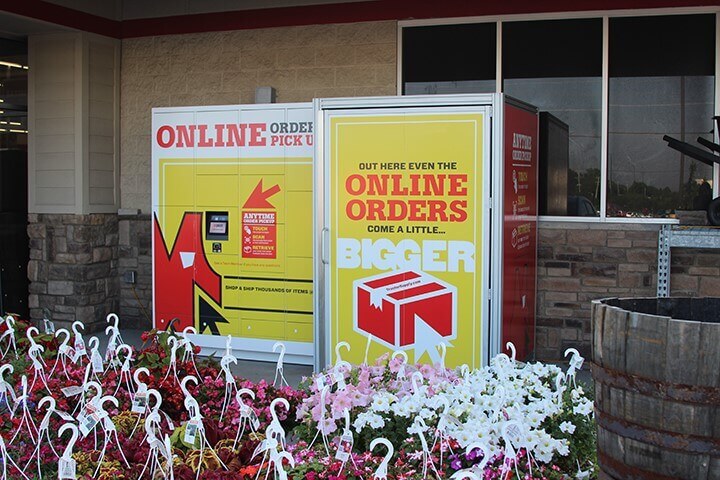
3. Zero Inventory Through Dropshipping
Dropshipping is a popular order fulfillment method used by many online Sellers. Dropshipping is an ecommerce business model that allows retailers to sell products without holding onto inventory. Instead, the retailer forwards customer orders to a third-party supplier who ships the product directly to the customer for a fee. Sellers don’t stock the items in their warehouse, effectively making it a zero-inventory business. When an order for a dropship item is received, the Seller purchases the item from a wholesale supplier who ships the order directly to the customer on behalf of the Seller. Sellers don’t handle or even see the product in the whole process.
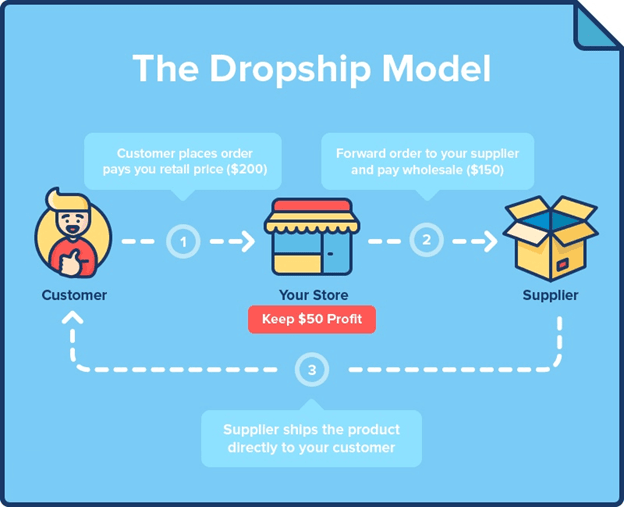
Dropshipping has a host of advantages as the online Seller does not require capital to pre-purchase inventory, does not need a warehouse to store it, and doesn’t even need expertise in order fulfillment and operations. However, the Seller must contend with low margins and no control over fulfillment. Therefore, dropshipping should be pursued by Sellers who intend to focus on building a diverse and creative product portfolio and concentrate on marketing to drive sales and revenue growth.
In the dropshipping model, the suppliers assume the risk of unsold inventory, though it’s minimal as they tend to have many affiliates selling their wares, and they pass the cost of logistics to the dropship Seller. Running an assetless business and maintaining low operational costs allows you to offer free shipping while concentrating on improving your sales without worrying about fulfillment.
Another form of dropshipping is cross-docking. In this ecommerce business model, instead of the wholesaler shipping orders directly to their affiliate’s customers, they bulk ship all the days’ orders to the merchant’s warehouse, who then fulfills all the customer orders. Cross-cocking tends to be used by merchants that already have the fulfillment infrastructure and the sunk costs of operating a physical ecommerce business. However, this strategy enables them to sell an expanded product catalog with lower product pricing and logistics fees, which results in higher profitability at a lower risk profile comparable to pure-play dropshipping.
4. Streamlining Your Supply Chain
The supply chain, in general, is not easy to manipulate. However, it’s a good idea to step back and reassess your supply chain for opportunities to improve your cost structure and allow you to offer free shipping.
Here are a few high-level recommendations to streamline your supply chain:
Optimize Sourcing: When you first open an online store, you would typically start with the easiest product sourcing options. As you scale and increase your bargaining power, though, you should look beyond the current sourcing and look for alternative suppliers that align with your selling strategy, which can be a cost leader, highly differentiated, or anywhere in between. You should also consider talking directly with manufacturers, if you’re not already (and using a broker or aggregator), and have a conversation about how you can bring your landed costs down. For example, sometimes overseas factories have preferred freight forwarders with much better ocean container rates than you might currently have available. Ask your 3PL/4PL if they can help with container shipping rates for the same reason…they can often get better rates by aggregating volume across clients.
Optimize Your Order Fulfillment Location: Ecommerce allows businesses to operate from anywhere they can get an internet connection. But as you scale, the inbound and outbound shipping becomes one of the most significant contributors to fulfillment costs. Moving your fulfillment location closer to the customer can save you money AND delight customers with faster shipping; middle of the country, for example (if more than one warehouse is not feasible, though Cahoot makes it easy to add warehouse locations to your existing setup to improve efficiency and reduce cost). On the other hand, being closer to vendors will help you reduce lead time and inbound costs. Both of these factors should be considered in deciding the optimal fulfillment center location. In addition, some locations also enjoy cheaper warehouse rents, cheaper labor costs, and may have government incentives. Taken together, an optimized fulfillment infrastructure can sometimes save substantial money.
Reduce Inventory: As an ecommerce business grows, the common reaction is to increase the size of the warehousing facility as well as the inventory on hand to meet the customer demand. But inventory is a cost trap and increasing inventory should be avoided as much as possible. Explore options such as reducing lead time from suppliers and getting rid of slow-moving inventory. Drastic measures such as liquidation and promotional sale of obsolete items should be standard practices in an industry with dynamic SKUs.
Consider Distributed Inventory: Distributed warehousing is a well-known solution for offering fast and free shipping. Whether leveraging a 3PL service such Amazon FBA, Multi-Channel Fulfillment (MCF), or a 3PL that has many locations, the benefits of distributing inventory to minimize final-mile shipping cost can often improve margins enough to be able to offer free shipping.
Multi-Channel Sales: Many studies have shown that the advantage of selling on many channels is huge. You reach more customers and the topline sales growth increases. This is not different from the conventional brand offering their product through the flagship store, departmental stores, specialty stores, or even outlets. In a similar vein, online shoppers have different channel preferences, and as such, different channels tend to command the attention and loyalty of different demographics. For example, Gen Z is more likely to shop via social channels and be drawn to influencer marketing while millennials prefer comparing different marketplaces and stores. Mix up your strategy to reach more eyeballs to grow revenue and earn the budget needed to cover free shipping.
5. Optimize Shipment Packaging
Packaging is an often-overlooked opportunity to optimize shipping costs. Shipping costs are dependent on the size and weight of the package, and online Sellers should look to cut down on both while choosing the optimal packaging. Shipping “air” is throwing money out the window.
If you are using small cardboard boxes, you can cut down on weight and size both by going with poly bubble mailers (if the product can ship and deliver safely in one). Poly mailers are versatile and can accommodate different shapes and sizes of items while keeping the cubic volume and weights low. For example, a poly bubble mailer of size 7.5” x 12” can weigh just 0.5 ounces compared to 3.6 ounces for a small 6”x6”x4” box. Be mindful of only shipping small and strong items using poly mailers like books, cables, or kitchen gadgets. For apparel, some brands like Abercrombie & Fitch use un-padded poly mailers that cost and weigh even less than their bubble-padded brethren.
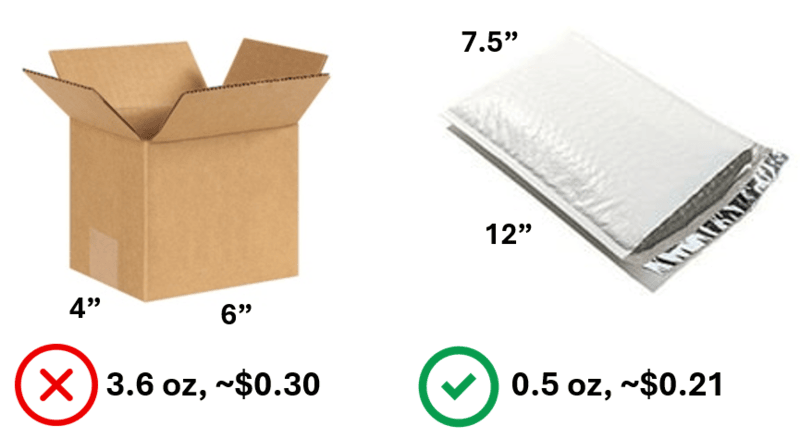
Another way to cut costs is to use carrier-provided boxes or packaging. All carriers give away free packaging for specific classes of mail. If you are shipping within that service, buying a separate box and affixing the label to it may be more costly than just going with the carrier-provided packaging.
Lastly, consolidate shipping supplies into the 20-ish sizes that are used most often and negotiate bulk discounts to help reduce your packaging costs. As a part of the exercise, take the time to optimize your packaging sizes around the frequency of multi-line/multi-quantity orders by SKU. In other words, figure out the most frequently ordered quantities for your products and purchase the packaging that is optimum for those orders. For example, you may be using the same package to ship multiple quantities of an item like soap. But if your box is designed to accommodate 5 units of soap, and your most commonly order quantity is 2 units, you should consider getting a separate smaller package and save money on the cheaper box or mailer and lower shipping cost. It increases complexity but will save money over time.
Smart cartonization software can be worth its weight in gold and could protect most of your shipping budget by itself by helping you automatically ship in the most economical packaging, minimizing the amount of shipped “air” and extra cost associated with the larger shipment. It can also help you track packaging inventory and alert you when you’re running low.
PRO TIP: Order packaging in bulk directly from overseas manufacturers for the most impactful savings. Buying from domestic suppliers allows you to buy Just In Time and minimize how much is spent at once, but the advantage of saving ~30 – 40% on shipping supplies may far outweigh the convenience of local sourcing in the long run.
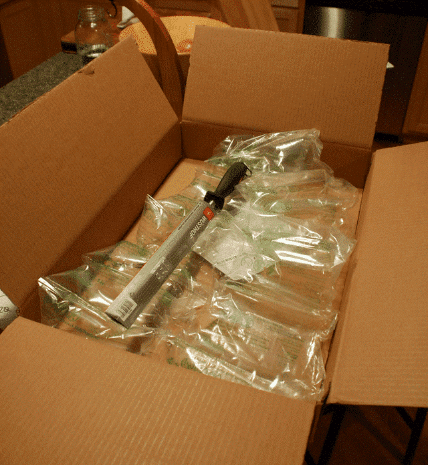
6. Reuse Packaging from Inbound Orders
There are two main benefits of reusing supplies from inbound orders. The first is reducing waste (most used shipping supplies are sent to the landfill), and the second is reducing the supplies you need to buy. Packaging supplies like boxes, mailers, and void fill may look trivial when you consider the cost of 1 unit, but en masse, the costs can really add up because they apply to every order shipped.
If you offer fragile or sensitive items that require special packaging, chances are some materials from your inbound shipments can be reused. For example, reusing void fill materials like bubble wrap, peanuts, or crinkled paper can reduce your spending on new supplies while reducing waste. Of course, the amount that can be reused may vary from each Seller, but it’s generally a better idea to reuse before finally recycling them.
Inbound boxes can also be reused to save money here and there, especially if you’re shipping larger items. But be aware that customers can be sensitive to what their package looks like when it’s delivered. If a reused box has old shipping labels, stickers, tape, and/or writing on them, they may have a poor experience and may not buy from you again.
7. Warehouse Robots
Autonomous mobile robotics (AMR) is an exciting innovation in warehousing operations that helps reduce the costs of the picking, packing, and sorting parts of the fulfillment workflow. The robots eliminate the cost of labor from these steps while increasing efficiency. Fulfillment is faster and there are fewer mistakes when a robot conducts an operation. Currently, order fulfillment centers that have robots working alongside humans can transport many more items at once, and in some cases, the complete rack of shelves are brought to stations manned by humans, rather than humans going to the shelves to pick products.
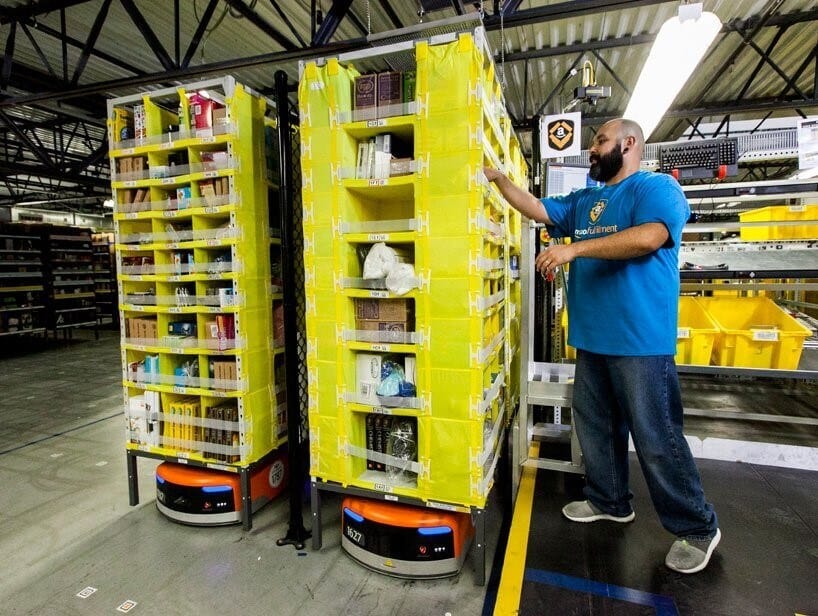
In other cases, robots speed-sort items by weight and volume to be packaged accordingly for different shipping services. This reduces human error while increasing fulfillment speed.
Kiva Systems and 6 River Systems have been two breakthrough AMR robot developers that have helped lower costs significantly for ecommerce Sellers. Kiva specializes in moving the entire shelf of products mentioned previously and was acquired by Amazon for the exclusive use of Amazon fulfillment centers. 6 River Systems was acquired by Shopify and is best known for their collaborative mobile robot named “Chuck” that uses sensors to navigate warehouses, avoiding obstacles and slowing down around people and equipment, guiding workers through their work zones to reduce walking and increase efficiency.
According to Amazon in 2016, Kiva robots cut the cost of warehousing by 20%, which amounts to more than $22 million dollars per warehouse per year. It is estimated that Amazon could save as much as $2.5 billion per year if the robots were deployed to all facilities.
Using robots helps businesses cut the time required to fulfill each order. At the same time, it has allowed better utilization of space by building narrower isles and getting rid of handling mechanisms that were required before.
For a warehouse without any robots, simple solutions such as Automated Guided Vehicles (AGV’s) can be an entry level solution. They are used extensively on factory floors and follow a predetermined path to transport materials without human intervention. This helps reduce manpower. Another solution could be Autonomous Mobile Robots (AMR’s) that can identify their environment and information on packages, where items are located on shelves, and can be used for picking, putaway, sorting, counting, and replenishment tasks, reducing human intervention even further.
Summary
Successful ecommerce businesses don’t just offer free shipping, they master the logistics behind it. Whether through just-in-time inventory, dropshipping, or regional fulfillment centers, the right logistical decisions can make all the difference. Businesses that stay ahead in supply chain optimization will not only keep shipping costs under control but also position themselves for scalable, long-term success. The key is to continuously refine operations, embrace emerging technologies, and find efficiencies that drive long-term savings that can be reinvested into a growth strategy that includes free shipping. With the right approach, free shipping can become a sustainable and profitable part of your business.
Download The Ultimate Guide to Profitable Free Shipping
Frequently Asked Questions
How to lower supply chain costs?
Companies can reduce their supply chain costs by working with suppliers, choosing specialist logistics and warehousing firms, using technology to boost efficiency, and finding ways to reduce waste such as materials or time.
How to reduce the cost of supply chain?
Streamlined processes, efficient transportation, and optimized inventory management all contribute to significant cost savings. By minimizing waste and maximizing resource utilization, businesses can lower expenses and boost profitability.
What is an efficient supply chain?
Supply chain efficiency focuses on delivering quality products to customers at the lowest possible cost by maximizing such resources as materials and labor. Supply chain responsiveness focuses on customers’ expectations and strives to provide a quality product faster.
What is cost control in supply chain management?
It involves optimizing operations to deliver maximum value with minimum waste, thereby impacting the total cost of the products or services. Supply chain managers and leaders have a pivotal role in analyzing and optimizing the supply chain.
Where can I reduce supply chain costs?
Some examples include: avoid minimum order quantities, know your reorder point, get rid of obsolete stock, implement Just-in-Time inventory management practices, and use consignment inventory (or a drop shipping business model).

Up to 64% Lower Returns Processing Cost

Top 8 Marketing Strategies For Making Free Shipping Profitable
In this article
 21 minutes
21 minutes
- Intelligently Set Minimum Order Value
- Offer Free Shipping with Loyalty Programs
- Offer Free Shipping for a Limited Time Window or Amount
- Offer Free Shipping at Peak Seasons of the Year
- Offer Free Shipping on Returns Only
- Offer Free Shipping to First-Time Customers Only
- Offer Date-Certain Shipping
- Consolidate and Deliver Multiple Orders on Fixed Dates
- Summary
- Frequently Asked Questions
Free shipping isn’t just a perk, it’s a powerful marketing tool that influences buying decisions and customer loyalty. It’s a deciding factor in where and how people shop. Shoppers are bombarded with choices, and offering free shipping can be the difference between an abandoned cart and a completed sale. However, without a strategic approach, it can also become a financial burden that eats into profits. The key lies in leveraging free shipping as part of a well-planned marketing strategy; one that drives conversions, increases average order value, and strengthens customer retention. In this article, we’ll explore 8 innovative ways to make free shipping work for your business without sacrificing your bottom line.
1. Intelligently Set Minimum Order Value
It would be best to avoid delivering low-cost items for free as their shipping costs are often higher than the cost of the item itself, leaving only so much margin. Setting a minimum order value in your shopping cart helps you generate enough margin to recover some of the shipping cost. One study has revealed that about half of the shoppers will add additional items to their shopping cart just to qualify for free shipping, making a great case for setting a minimum order value for free delivery.
However, be mindful that there’s a fine line between setting a minimum order value that will increase total sales and one that will drive away the customers. There are different ways to test what that right amount is. Don’t set a limit too far away from your average order value. It should be just enough for customers to add a couple more items at most.
The following is a simple model developed by a data analytics company, RJ metrics:
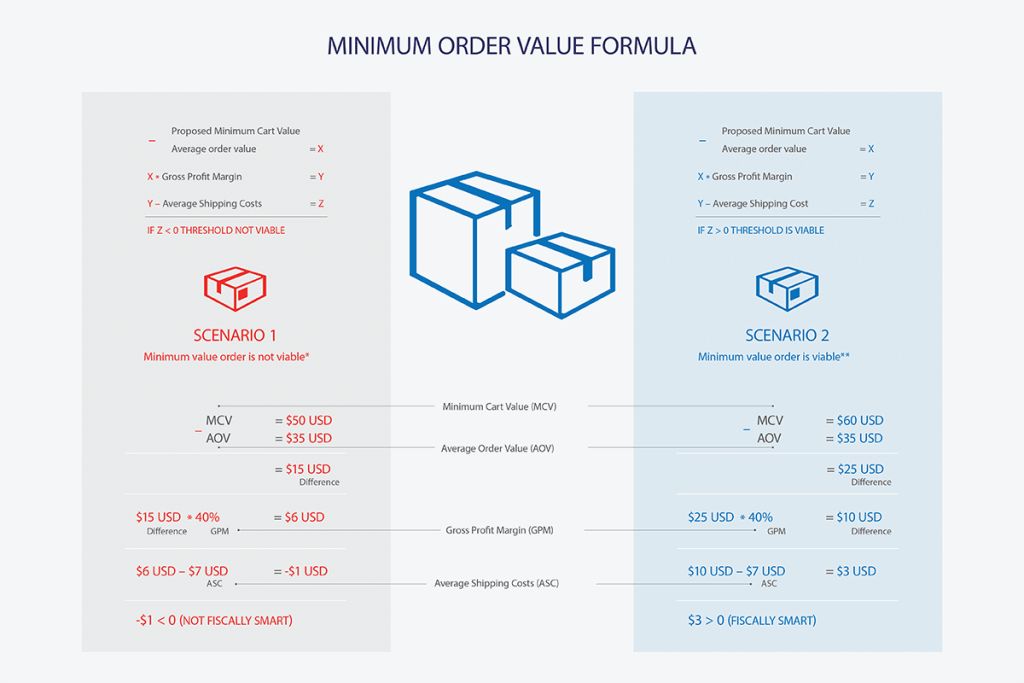
To learn more about calculating your minimum order value, check out this guide by DSers.
2. Offer Free Shipping with Loyalty Programs
Loyalty programs are customer memberships offered by retailers in exchange for various perks, including free shipping. The customer is charged a fee or must collect points against regular orders to enjoy the perks of the membership. It is designed to encourage repeat purchases, enabling retailers to absorb the shipping costs.
Some big retailers offer the membership to customers for free; solely in exchange for basic personal details such as email account, name, address, gender, and birthday. Retailers use this information to encourage more purchases through targeted marketing efforts. They leverage customers’ purchase history and demographics to send special offers and personalized catalogs.
The increase of purchase frequency from a loyalty program is reflected in the customer lifetime value (CLV), which is the basis for most loyalty programs. CLV refers to the dollar amount that a customer is worth to you between their first and last purchase from your business. It is easy to calculate with a formula:
CLV = ((Average Order Value) x (Average Gross Margin) x (Average Number of Transactions per customer over a year) x (Average Lifespan of a Customer in years)) + ((Loyalty Program Fee per year) x (Average Lifespan of a Customer in years))
For a loyalty program to be successful, CLV should increase when compared to CLV without the loyalty program. Let’s walk through an example. Before loyalty programs, if your Average Order Value was $50, Average Gross Margin was 20%, the Average Number of Transactions per customer over a year was 8, and customers only stayed for 1 year (Customer Lifespan), then:
CLV: ($50 x 20% x 8 x 1) + $0 = $80
Now suppose you offer free shipping for a yearly fee of $50, you’ll see a few changes in your metrics. Your Gross Margin goes down to 10% because of $5 assumed average shipping expense per order, but the customers are likely to stay with you for twice as long (that is two years). In this case:
CLV: (($50 x 10% x 8 x 2) + ($50 x 2)) = $180
Since there is an increase in CLV despite a decrease in Gross Margin, the loyalty program worked in this case. And this estimate has not accounted for increased purchase frequency from customers wanting to take advantage of the free shipping.
Even if you don’t charge a monthly fee, the point system is a good alternative. The points-based system encourages customers to keep shopping and take advantage of free shipping. Also, it can be designed to ensure there is enough additional margin to make up for shipping costs. Another driver of sales are tailored offers and product catalogs.
In some cases, loyalty programs such as supermarket cards end up being a discount program without getting any more loyalty from the customer. Customers get membership cards from all supermarkets they visit and either shop all the discounts across all supermarkets or shop for the one with the most discounts on a given shopping trip. So it’s not really a loyalty program as much as it is data collection that helps the store offer even more discounts by way of additional tailored coupons. Therefore, it is necessary to design loyalty programs to increase your profitability and reward increased spending.
A few good examples of membership programs designed around free shipping would be Instacart, Shipt, and Walmart. Instacart and Shipt’s annual memberships provide free grocery deliveries for orders over $10 and $35, respectively, at $99 per year, which basically encourages a monthly shopping behavior from its members (other service fees apply). Walmart+ is Walmart’s subscription-based loyalty program with a price tag of $12.95 per month or $98 per year, with no order minimum.
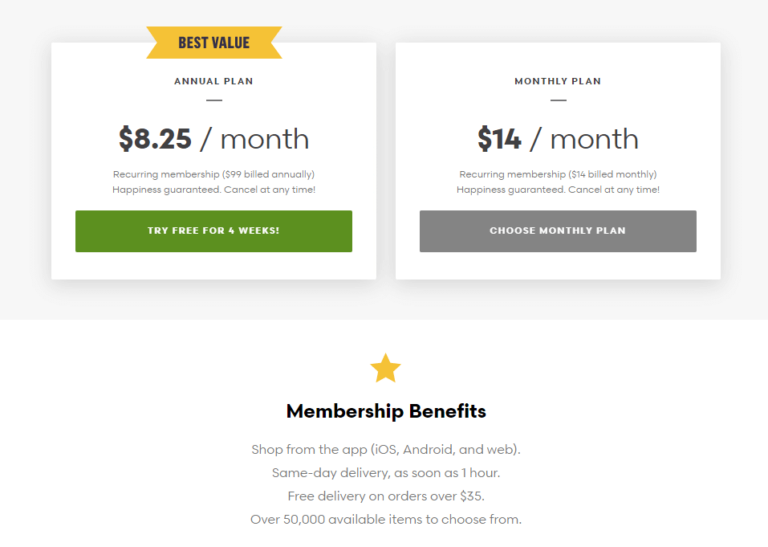
A few retailers that do unpaid loyalty well are Sephora, ShopRunner, and Starbucks. If you look at the Free Sephora Beauty Insider program, it rewards dedicated beauty shoppers with more than discounts and free shipping; it offers a free birthday gift, exclusive events, and other extra frills. Customers are encouraged to buy more and stay on to reap the benefits tailored right for them.
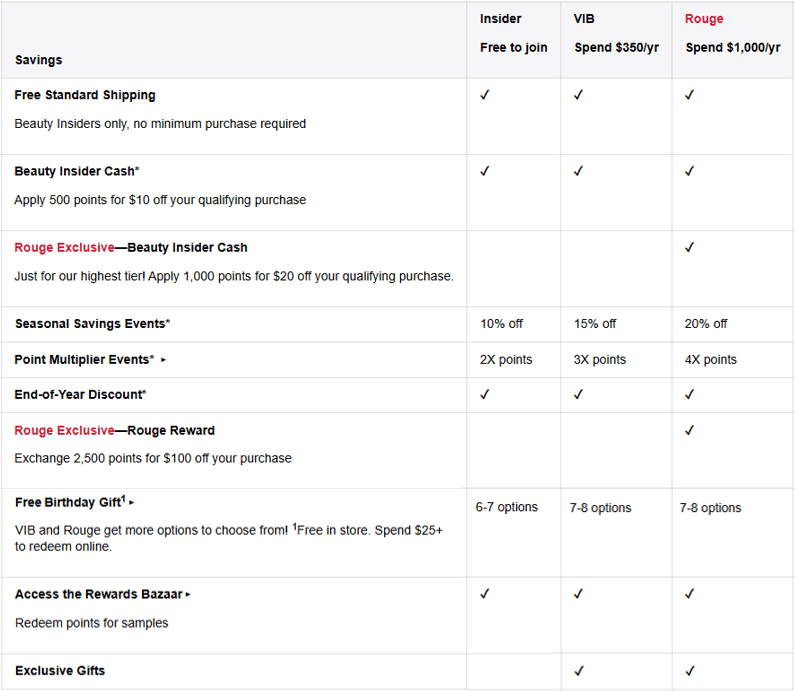
Another unique membership program is Shoprunner, which partners with high-end luxury retailers to provide free 2-day shipping and free returns for its members. The membership is currently free for customers, potentially charging the retailers for the express delivery service.
The well-known Starbucks Rewards program is points-based and rewards customers with stars based on the number and value of their purchases that can be redeemed for free drinks and food. Going beyond basic points, it comes with a free birthday item, access to exclusive games and games, free refills on certain drinks, skip-the-line with Order Ahead, and more.
3. Offer Free Shipping for a Limited Time Window or Amount
If you’re not yet set to offer free shipping all the time, free shipping for a limited time serves as a great marketing tool in many cases. The purpose of providing free shipping here is to encourage additional purchases and build a relationship with the customer for future business.
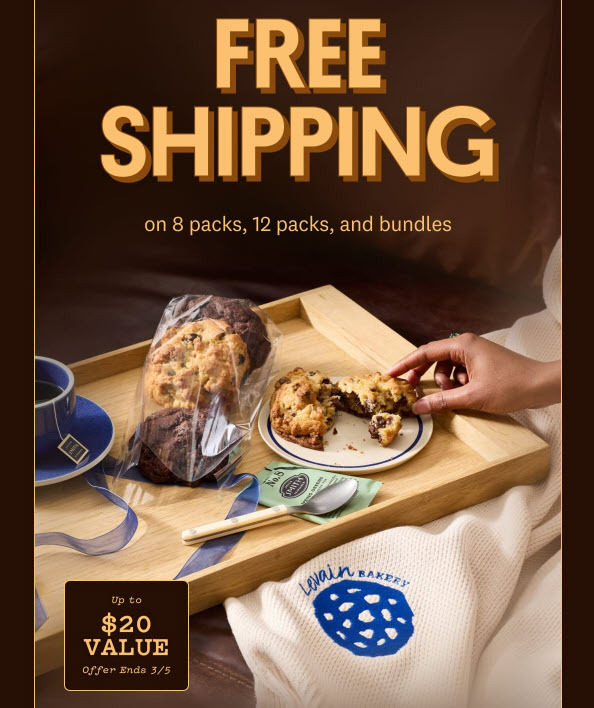
Very simply, you need to set a target of future incremental sales from customers who have used the free shipping promotion. The margins from incremental sales should cover the costs of shipping during the offer and help you assess the success of your campaign. Additionally, just acquiring more customers could increase brand awareness, which will attract new prospects organically in the future.
One way to make this limited-time offer work without sacrificing too much profitability is to adopt value limits. Like in the cookie example above from Levain bakery, the free shipping discount is limited to $20 because the cookies need to ship using 2nd Day Air services, which can quickly get very expensive. The amount is enough to provide free shipping to neighboring states but will not be enough to cover cross-country shipments.
If you have a high engagement rate on your web store but a low conversion rate, that means customers need a nudge to complete the checkout. Offering a limited-time free shipping offer will excite prospective buyers and turn window shoppers into paying customers. Temporary free shipping can be an excellent investment to boost sales during slow periods. It is essential to be careful about frequency to not habituate the customers to free shipping.
You can be creative by offering a limited time offer through different shipping strategies:
- Offer free shipping on next purchase to customers only after checking out. This acts as a reward for shopping with you and encourages the customer to explore your catalog for future purchases.
- Offer customers free shipping when they share their purchases on social media or after writing a product review. Here, you are using free shipping to increase your exposure and potential sales via consumer generated content.
- Send a free or discounted shipping promo code by email or text if a cart has been abandoned.
The broad idea is to invest in the shipping cost for a few orders to acquire more customers and get more future orders.
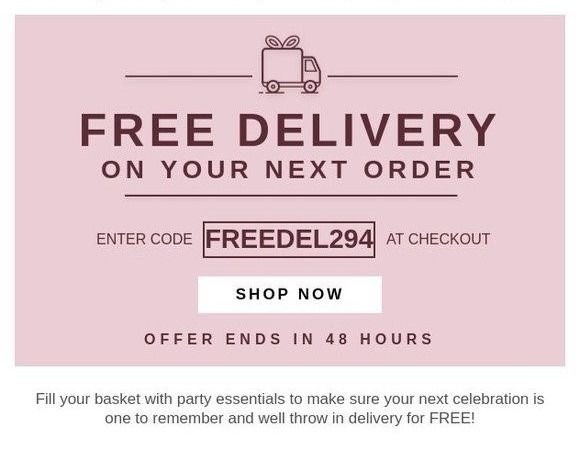
4. Offer Free Shipping at Peak Seasons of the Year
Free shipping is not a value creation strategy if you do not have enough sales to increase your bottom line with reduced unit margins. Therefore, offering free shipping during peak season could be a better idea. One, there is potential for more sales, and two, you need to be competitive when everyone is offering some kind of promotion. Free shipping is “a cherry on top” of any other promotion.
Every business has a seasonality to it. Depending on your products, test out free shipping offers during different times of the year such as Christmas, Mother’s Day, Valentine’s Day, Amazon Prime Day and Back-to-School.
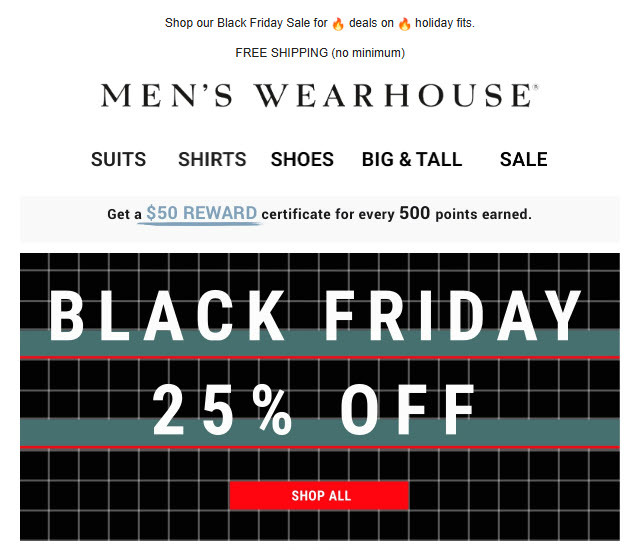
Third-party Sellers on various marketplaces such as Amazon could also benefit from offering free shipping during their flagship sale day. Increased customer traffic on Amazon during Prime Day can work in your favor only if you can stand out. Even if you don’t offer free shipping all year round, temporarily offering free shipping could help you convert a larger share of the increased traffic to the site.
Best Buy has been offering free shipping to all customers during its peak holiday sales season. Target, on the other hand, offered free expedited shipping before Christmas on most of its items. The key was to increase sales during the peak season and get an even bigger share of the pie than usual.
The objective of this shipping strategy is to increase profits by increasing gross sales at a lower margin but be mindful of not losing money on every sale. Customer acquisition can be a secondary goal, but the primary purpose of this shopping lift should be to increase your overall profit. It’s possible that customer spending on your site during the off-peak season might not cover the promotional free shipping losses incurred during the peak season, so you may have to wait until the following year for a possible pay-off. Therefore, be selective about what products you offer with free shipping.
5. Offer Free Shipping on Returns Only
The prominence of online shopping has made returning products much more important in recent years. Customers care about the ability to return the item if they are not satisfied with it almost as much as free shipping. Therefore, there is an opportunity to attract customers by offering free shipping on returns as a feature of shopping with you.
There are a few categories where the customer thinks about returns even before they have made the purchase. These are the products that conventionally require a trial. Anything in the fashion category, house décor, and jewelry fit are example categories.
When customers shop for clothes, they cannot be 100% certain of the fit or how they would look wearing the product. The risk of losing the conversion is higher if returns are complicated (e.g., how to print a shipping label, how to mail the return, who pays the return shipping and how much will it cost, etc.). This creates a lot of hesitation to complete an online purchase unless the return policy is simple, clear, and customer-friendly. Free returns take the fear out of monetary loss from unsatisfactory purchases. For example, kurufootwear.com, an exclusively online footwear store, advertises free returns explicitly.
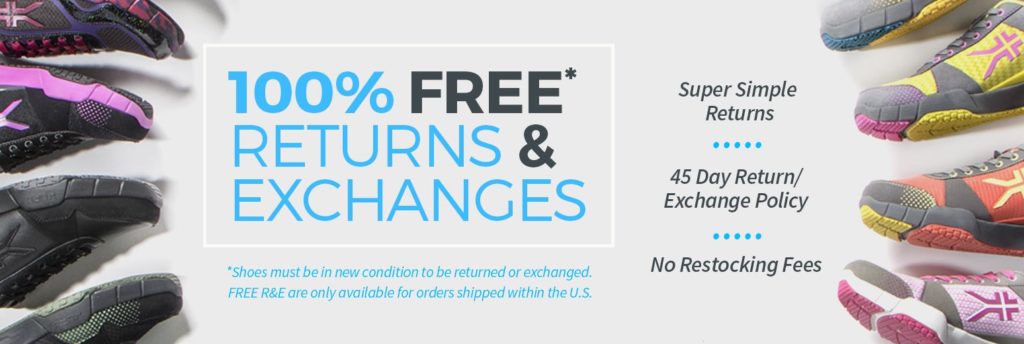
Free returns can become very costly for items that have high shipping costs such as a couch or television. Therefore think about what products are worth offering with free return shipping. Products that are light and small with good gross margins are good candidates as the reverse shipping costs won’t eat up all your profits. Expensive or high-end luxury products are prime examples of products that enjoy a good margin and are excellent candidates for free return shipping.
Nevertheless, try to keep returns to a minimum by helping customers choose the right item in the first place. This can be done by having a detailed product information section, several size charts, FAQs, and useful visualizations.
Besides making it free, make sure that the customer receives hassle-free service during the return process. This can be achieved by giving them clear instructions on the site or including a pre-paid return shipping label inside the original package itself.
6. Offer Free Shipping to First-Time Customers Only
Getting customers to try your products can be the biggest hurdle in growing your ecommerce business. Offering free shipping could be the nudge that customers need to buy from a new online Seller. Such an offer makes sense for a retailer who is looking to broaden its base or acquire new customers.

It is a simple but effective shipping strategy. Many successful businesses, such as Postmates or Grubhub, have used it in the past to get the customer on board. Once the customers realize the value of the service, they stay on to become regular paying users.
Whether you’re an existing ecommerce Seller with a new product offering or a brand new online store, free shipping on the first order can get the product out into the hands of new customers. This is especially useful in consumable categories like pet food, coffee and vitamins where customers tend to order the products at routine frequency but are not sure if they are ready to commit to the product or the Seller just yet. It can be considered as an online version of free sampling.
7. Offer Date-Certain Shipping
When free shipping is not an option, showing guaranteed delivery dates helps manage customer’s shipping expectations. Online Sellers should explore offering customers options for different delivery dates with different shipping charges. The slowest one might be offered free, but it still has a guaranteed date of delivery.
Guaranteed dates also help customers to make decisions faster because it takes out the mental math of “delivers in 5-7 business days”. Amazon and Walmart have used this shipping strategy successfully for a long time. Amazon has increased the accuracy of delivery date moving from a range to a specific date for this very reason.
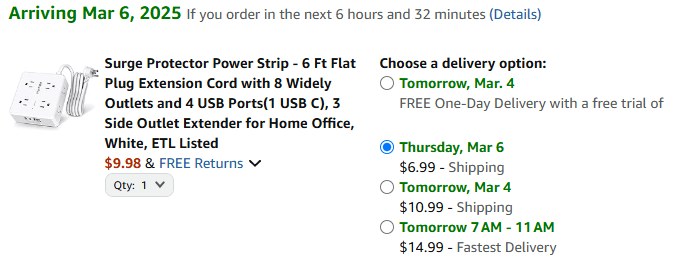
A Seller should keep a couple of things in mind while implementing date-certain shipping options. They should create a sense of urgency by showing how long the delivery date promises will be valid before they change based on same-day shipping cutoff times (e.g. “If you order in the next…”). Moreover, the tracking should be made available to the customer in great detail to create transparency and further decrease anxiety.
Such options ease the customer’s mind because they can see the trade-off between spending more on shipping compared to the resulting delivery delay. This lets different types of customers choose and complete purchases depending on which tradeoff has a higher priority.
8. Consolidate and Deliver Multiple Orders on Fixed Dates
Explore the possibility of consolidating all your orders and ship them all together on dedicated days to decrease overall logistics costs. This strategy can be used in conjunction with zone-skipping and applies to 1) fulfilling single-customer orders, 2) fulfilling multiple orders for the same customer, and 3) transporting goods between your warehouses and B2B customers such as retail outlets.
For the first one, examples would include crowdfunding campaigns and preorders, where the availability of a product such as a Kickstarted Boardgame project or new release music becomes available all at once in bulk. By presetting customer expectations about shipping and estimated delivery dates, you can offer economical shipping options by processing orders in bulk (just one time), thereby reducing labor and related fulfillment costs as well as longer transit options such as hybrid shipping services.
For the second one, this works well if you have repeat business coming from the same customers (DTC or B2B) on a recurring schedule. By grouping orders from a customer throughout the week, for example, and shipping all orders together on a pre-determined day of the week, (e.g. “Amazon Day”), shipping and logistics cost are minimal compared to shipping them all in real-time.
For the last one, this works well if you have a brick-and-mortar presence. The main idea is delaying inventory replenishment until you have a full truckload of goods per shipment (going out or coming in). Shipping efficiently (a full truck) reduces the logistics cost of each item carried. Having a good demand forecast is key in minimizing stockouts and estimating optimal shipment schedules. A set shipment schedule provides carriers certainty of future business and can help in your negotiations as well.
Summary
Free shipping isn’t just about meeting customer expectations, it’s a tool that can be leveraged to grow your business. By structuring your promotions thoughtfully, whether through minimum order thresholds, loyalty programs, or limited-time offers, you can encourage higher or more frequent spending while keeping costs under control. The best marketing strategies don’t just attract customers; they create long-term relationships. With the right approach, free shipping can not only increase immediate sales but also build a loyal customer base that returns again and again, making it a cornerstone of your long-term success. The secret lies in understanding your margins, leveraging data-driven insights, and continuously optimizing your approach.
Download The Ultimate Guide to Profitable Free Shipping
Frequently Asked Questions
Is free shipping a marketing strategy?
Free shipping is a marketing strategy by online stores that allow shoppers and customers not to have to pay an additional fee when placing orders for particular items. From the online shopper’s perspective, getting no additional cost to an item purchased from a website makes shopping much easier.
How to advertise free delivery?
Consider offering free shopping when purchasing 3 or more items. Another example of promoting this method is: let’s say a customer reaches the checkout page, you can recommend other products with a message saying, “add one more product to your cart to be eligible for free delivery.”
Does Free Shipping Increase Sales?
Free shipping significantly impacts sales by reducing cart abandonment rates and increasing purchase conversions. Studies indicate that customers prefer free shipping over paid options, which can lead to higher sales volumes.
What are free shipping promotions?
Free shipping is an increasingly popular option for online shopping, where customers do not have to pay an additional shipping charge. Free shipping is attractive to customers who appreciate simple pricing structures, making it a potential competitive advantage for online businesses.
How do you determine the minimum value for free shipping?
To calculate your free shipping threshold, you need to know your average order value (AOV) and your average shipping cost (ASC). A simple formula is to multiply your AOV by 1.5 and add your ASC.
Why free shipping is not free?
For cheaper items, you simply can’t absorb the cost of shipping. If your product costs $6 and the cost of shipping is $8, you are going to lose money by offering free shipping. Your margins may differ across products, depending on the cost of manufacturing, as well as the size and weight of different items.

Up to 64% Lower Returns Processing Cost

Top 12 Shipping Strategies For Making Free Shipping Profitable
In this article
 31 minutes
31 minutes
- Structured Negotiation with Multiple Carriers
- Convince Suppliers to Use Your Shipping Account
- Use Trade or Group Association Discounts
- Use Shipping Label Software
- Maximize Ground Shipping Services
- Try Amazon Shipping
- Take Advantage of ‘Hybrid' Shipping Services
- Consider a Regional Carrier or Regional Rates
- Avoiding Residential Address Surcharges
- Use Zone Skipping for High Volume Zones
- Use International Freight Forwarders to Fulfill International Orders
- Selling Internationally through Full-Service Cross-Border Solutions
- Summary
- Frequently Asked Questions
For ecommerce sellers, shipping is more than just getting a package from point A to point B — it’s the invisible backbone, quietly shaping customer satisfaction, operational costs, and, ultimately, your bottom line. Yet, as carriers raise their rates and consumer expectations for fast, free shipping continue to rise, businesses are left with a difficult choice: absorb the costs, pass them on to customers, or find a smarter way to optimize logistics to avoid sacrificing profit.
The good news? You don’t have to choose between customer satisfaction and profitability. With the right shipping strategies — whether it’s negotiating better carrier rates, using regional shipping options, or leveraging technology to streamline fulfillment — you can reduce costs while maintaining service quality. This guide explores key tactics to help businesses of all sizes take control of their shipping costs and turn logistics into a strategic advantage.
1. Structured Negotiation with Multiple Carriers
Shipping costs are easily the biggest component of your order fulfillment prices, worse if you happen to sell big bulky items. But the problem is, every year the carriers increase their rates while you have to keep prices low to stay competitive. Giants like Amazon can afford to subsidize their deliveries, but how are you to offer free shipping as a small business?
Well, a lot.
With Amazon’s transportation business, Amazon Shipping, enabling the company to reduce its reliance on USPS, UPS, and FedEx, these national carriers are doing all they can to retain their customers. For these carriers, every bit of business is important to retain shareholder value. This presents you with the perfect opportunity to pull up your socks and put on your negotiation cap.
The key is shopping around and negotiating with your carrier Account Manager (if you have one). Chances are you’ll get a better deal if you can convince carriers that you are a reliable source of repeat business. First, you’ll have to gather what your business’ shipping needs are and then you formulate a formal Request for Proposal (RFP). This RFP document will help carriers assess your needs and tailor a deal for you. It’s easier to distribute this document across multiple carriers rather than setting up one-on-one discussions with everyone too early in the negotiation. For more details, Logiwa does an excellent job of explaining how to go about it.
There’s a merit to being well-prepared for your negotiation. Be sure to really understand what sort of shipping profile your business has, ranging from:
- Breakdown of your historical shipping speeds (Ground, Express, Consolidation)
- Shipment weights and dimensional weights
- Percentage of residential vs. commercial deliveries, including weekend deliveries
- How often errors and corrections like address changes and incorrect weights occur

Having a clear sense of what your business really needs helps you avoid paying for features you don’t really need in your deal with the carrier and makes sure that you do negotiate for the items that you use the most. Pulse Commerce also has a great in-depth article on how you can negotiate better rates using shipping data and analytics.
2. Convince Suppliers to Use Your Shipping Account
You might be leaving money on the table if you use your shipping account for only outbound shipments from your warehouse(s). Most ecommerce Sellers get inbound inventory shipments from their suppliers. If you’re one of those merchants, it would be a good idea to convince your suppliers to send them using your shipping account, meaning the carrier will bill you directly for the inbound shipment. This translates to more shipping volume on your account, and if we learned anything from the first tip, the more volume you have the more bargaining power you’ll have as well. In addition, you might already hit a higher volume discount even before further negotiations.
There are third-party contract negotiation/optimization solutions such as TransImpact, ShipSigma, and ShipRx, (among many others), that will analyze your shipping history for you, identify the most commonly used services, sizes, weights, and accessorial fees, and then help you negotiate your best agreement. With over 600 negotiable terms in a UPS contract, for example, outsourcing the work could make sense.
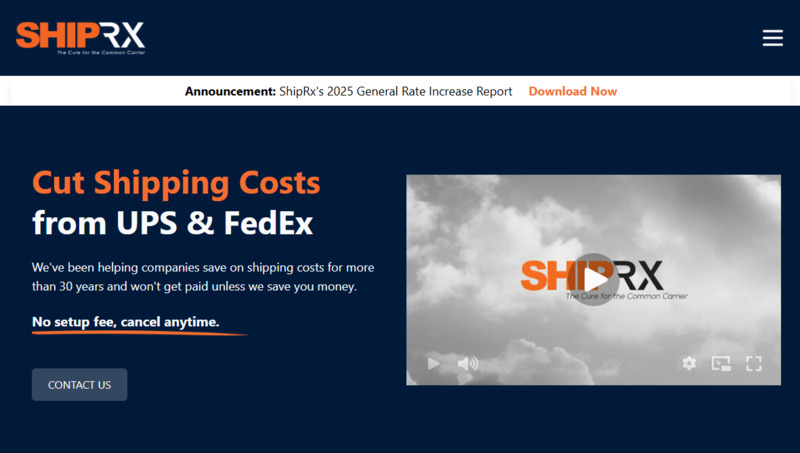
Lastly, make sure to request that any outsourced fulfillment partners also use your negotiated accounts. Modern ecommerce order fulfillment providers such as Cahoot have a Bring Your Own Carriers option that allows you to keep your volume on your accounts while outsourcing the fulfillment logistics to increase efficiency and lower cost.
A simple solution would be to set up a process through which suppliers can provide you with all the shipment details and you can provide them with the shipping labels. You can email those labels directly to them, and they can be printed, and packages can be handed over to the carrier.
3. Use Trade or Group Association Discounts
Trade organizations such as the American Bar Association or the Outdoor Industry Association are not just good for their annual conferences and shows, but they also offer a lot of advantages to their members. One of them is working together to help businesses reach scale when buying goods and services.
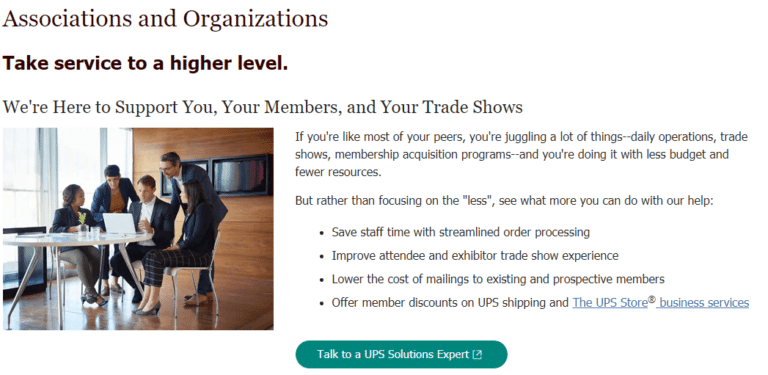
image courtesy: UPS
Shipping carriers often have relationships with many professional associations and offer member discounts. Depending on the size of the organization, you could be eligible for discounted rates of up to 50 percent with UPS and FedEx.
While UPS does not advertise the associations they offer discounts to, don’t hold back from asking your Account Manager or your association, whether you qualify. By aggregating your volume with that of your industry peers, you may just find that you’ve been missing out on a lucrative opportunity.
4. Use Shipping Label Software
There are two types of shipping label software we’re talking about in this tip: multi-carrier channel-integrated shipping label software such as Cahoot or ShipStation, and specific carrier websites that support online shipping label generation, such as USPS.
Shipping label software is an easy opportunity for Sellers who are new to ecommerce and/or haven’t reached the volume to qualify for negotiated rates or discounted 3PL services yet to get access to discounted rates. Cahoot, ShipStation and many others aggregate their shipping volume to negotiate big discounts with several carriers each and pass the savings onto their customers. Alternatively, you can print your shipping labels at usps.com instead of at the post office counter and enjoy the same reduced rates (commercial program) available to larger shippers. Discounted USPS shipping labels can also be purchased through authorized USPS postage services like Endicia which claims savings of up to 40%, whereas Stamps.com can save you up to 30% on Priority Mail services. Online shipping with USPS also saves you from carrying all your packages to the post office with its free parcel pickup service.
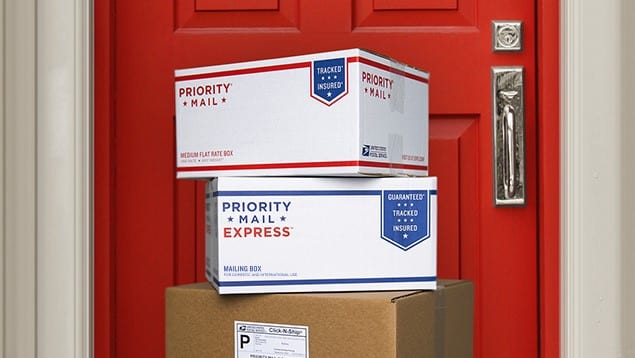
image courtesy: UPS
Using USPS is ideal only if you are shipping packages weighing less than two pounds. For heavier packages, it’s less expensive to go with the private carriers (FedEx and UPS). For private carriers, it’s best to open an account online rather than shipping them through the physical stores (e.g. The UPS Store and FedEx Office). These carriers reward the Do-it-yourself mentality! If you pay & print labels online and drop them off at the carrier store, you can save up to 50% compared to doing all of this directly at the carrier’s store.
5. Maximize Ground Shipping Services
Free shipping is a great motivator for shoppers even if it means getting the delivery a little later in some cases. According to a study published by McKinsey & Company in 2025, 95% of online shoppers prefer free standard delivery over paid expedited delivery, and 8 out of 10 shoppers are willing to wait even longer for a free shipment. Therefore, using the cheaper ground shipping option may be your best bet.
Similar to tip #3, which aims to add enough margin to the shopping cart subtotal to make free shipping viable, an alternative is to provide free shipping but at a slower speed. Consider offering a no-rush delivery option for customers willing to wait for free shipping. Ground shipping uses more economical long-haul trucks to move packages around the country rather than expensive air cargo, reducing the carrier’s costs and giving you better margins.
Here are some possible options for ground shipping from different carriers:
- FedEx Ground: Offers delivery to commercial destinations with the certainty of delivery on a pre-informed day. They deliver within typical business hours and the delivery timeline is between one and five days.
- FedEx Home: This is like FedEx Ground but with deliveries to residential addresses. It is slightly more expensive and has a wider delivery window, between 9 am and 8 pm. The delivery duration is between one and five days.
- UPS Ground: UPS Ground shipping is a ground delivery service that guarantees delivery on a specific date, similar to FedEx.
- USPS Ground Advantage: USPS Ground Advantage is an affordable and reliable service for sending packages to all 50 states, U.S. military bases, territories, possessions, and Freely Associated States. The delivery timeline is published as between two and five business days, but packages can be delivered in as little as one day. Rates are lower if shipping labels are purchased online as shippers benefit from commercial rates rather than retail rates if purchased inside a post office.
Check out this price comparison table using February 2025 rates for the ground shipping services described above to help determine which carriers to consider. Keep in mind that historically, UPS and FedEx have had more reliable on-time delivery:
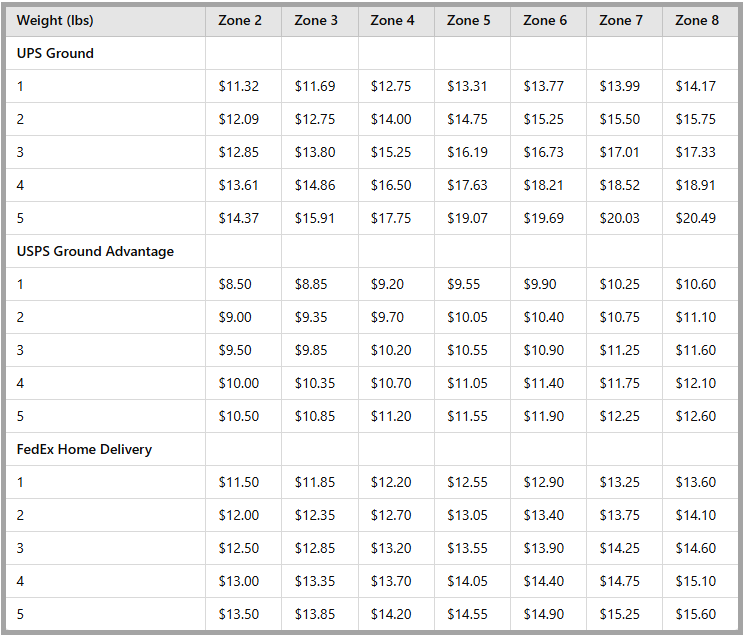
6. Try Amazon Shipping
Amazon Shipping is the newest last-mile shipping service meant to complement and partially replace existing national providers like UPS, USPS, and FedEx. It started by servicing only Fulfilled by Amazon (FBA) orders but has since been aggressively recruiting high-performing retailers to use Amazon Shipping at low teaser rates. If you are a top-rated Seller on Amazon and haven’t received any such invitation, you should reach out to your Amazon contact and try to make your case for it as it offers reliable delivery in two to five days to the majority of the contiguous United States. Pickup and delivery is available seven days a week with no additional weekend delivery fees or residential surcharges.
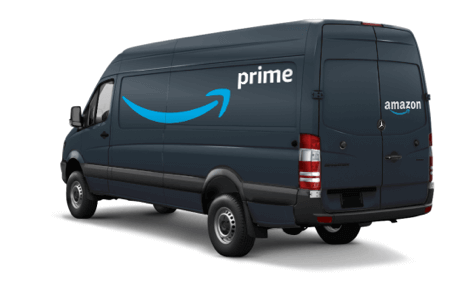
Amazon Shipping uses Delivery Service Partners (DSPs), that is, freelance partners delivering on behalf of Amazon, while Amazon provides the technology needed for drivers to successfully pick up and deliver packages. By awarding delivery routes to DSPs, the management of the fleet and employees is borne by the outsourced companies, the dependence on traditional shipping carriers is eliminated, and Amazon can offer fast deliveries at lower costs than the unionized national carriers.
Amazon Shipping can sometimes be cheaper than the discounted shipping rates that Amazon offers to merchants using its FBA program. With total control over operations and a contracted workforce, Amazon can run an efficient and lean operation and pass on incredible savings to its participating merchants.
7. Take Advantage of ‘Hybrid’ Shipping Services
Hybrid services are a great example of how competitors work together to increase value by working in their areas of expertise. The most expensive component of shipping is the last-mile delivery. And the ground distribution network, especially in residential areas, has never been strong for large national carriers such as UPS and FedEx. So they work together with USPS to offer ‘hybrid’ services; the moniker originates from this collaboration, (aka ‘co-opetition’, that is, cooperative competition), which makes it possible to leverage what each does best to maximize efficiency and lower costs.
Carriers supporting consolidation services collect large volumes of packages, sort them in their own ground network facilities, consolidate them, and then inject them into the USPS network way downstream for delivery to the doorstep (that USPS is already touching every day), effectively outsourcing the final delivery.
Consolidation services are using the USPS Parcel Select service that has a delivery timeline between two and seven days, however, these shipments are lower priority and can sometimes take up to 10 days to deliver. So while much less expensive than UPS, FedEx, and USPS Ground services, packages can take 2 to 5 days longer to deliver to your customer. If your business offers recurring subscription purchases like dog food, you may not care how long transit takes, you just need to ship a few days earlier to meet your customer’s subscription expectations.
Hybrid shipping services are ideal for packages weighing less than 10 pounds (the lighter, the better), and best for residential, non-urgent, low-value domestic deliveries. Outside of this sweet spot, the prices for hybrid services may be comparable to other service types but hybrid services will take longer to deliver.
Packages heavier than 10 pounds should use standard ground shipping or Priority Mail Flat Rate box (because if it fits, it ships; up to 70 pounds, regardless of distance). And the Priority Mail delivery expectation is 1 – 3 days, making it a good option for shipments that need to arrive quickly but don’t require expensive overnight services.
See the 2025 FedEx Ground Economy delivery details and package weight and size limits:
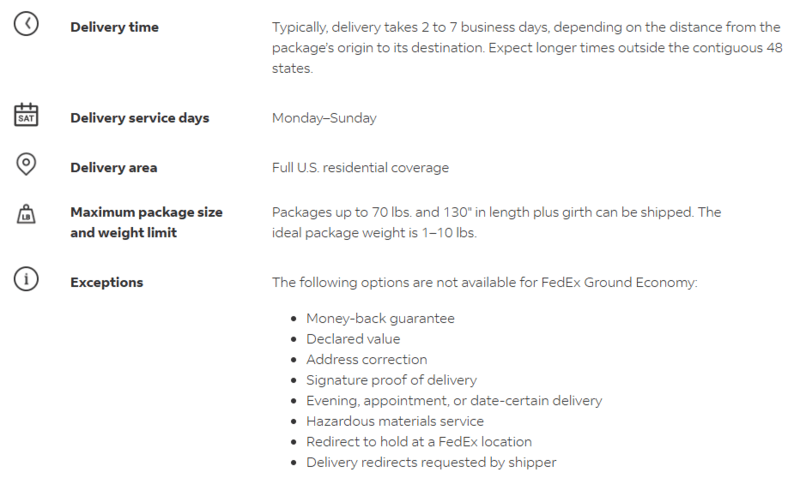
image courtesy: FedEx
Here’s a UPS Mail Innovations graphic depicting how consolidation services ‘skip’ steps along the USPS sortation and delivery journey and get injected into the USPS network much further downstream, often one step before residential delivery:
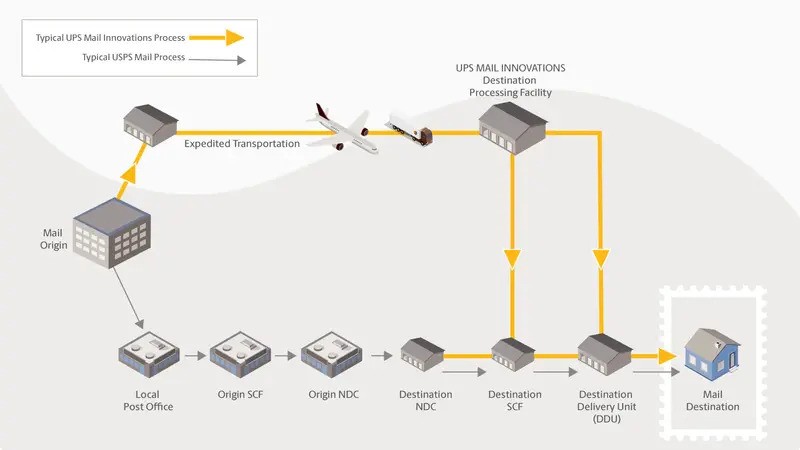
image courtesy: UPS
Note: there are substantial minimum volume commitments to qualify for free pickup of packages by many of the consolidation services. Some piggyback on existing infrastructure, while others require separate workflows and must be kept separate from standard ground shipping services. Make sure to understand how your workflows will change when implementing these services.
8. Consider a Regional Carrier or Regional Rates
Some carriers operate in specific regions only; they are often less expensive compared to FedEx or UPS because they operate in a smaller area and use mainly ground transportation for delivery. By avoiding expensive air cargo, ground services don’t have to help absorb some of the overall operational costs. Their delivery networks are typically limited, but many of them cover a wide range of states with fast deliveries. Some of the prime examples of such carriers are:
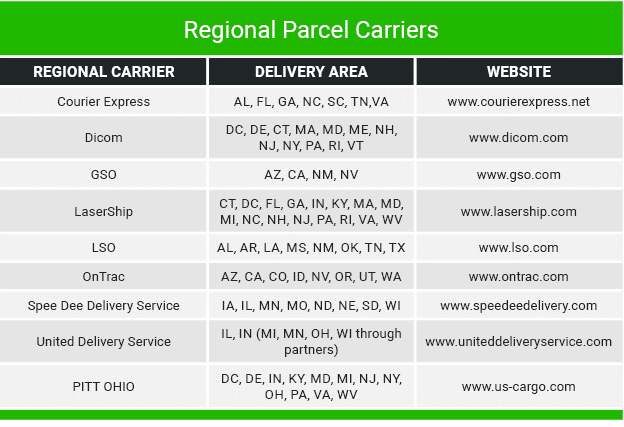
Note: LaserShip and OnTrac merged and now operate under the name OnTrac.
Regional carriers typically provide better services than national carriers because they specialize and operate in a smaller area. They can provide same day or next day delivery options for deliveries that usually take a couple of days through FedEx and UPS.
They are more flexible in accommodating the requests of online Sellers too. Since they have a smaller base of customers and fewer packages to handle, it is not uncommon for them to provide later pickup time and earlier deliveries.
9. Avoiding Residential Address Surcharges
UPS and FedEx, the biggest national carriers, add a surcharge for all shipments to residential addresses. A carriers’ definition of a residential addresses isn’t always clear, but you can reduce some of your costs by planning around residential surcharges and encouraging customers to ship to their office building or a commercial pickup location (e.g. The UPS Store, FedEx Office, or a Pickup Locker). Benefits to the customer include:
- Accurate Delivery: Carriers don’t leave packages at the wrong address by accident, creating a WISMO (Where is My Order) customer service event.
- Improved Successful Delivery Rate: Helps people living in densely populated, urban areas such as apartment buildings.
- Security and Safety: Office buildings often have secure access and reception areas, reducing the risk of packages being lost or stolen compared to home delivery.
- Convenience: Packages can be received during business hours without needing to adjust a personal schedule or worry about missed deliveries.
- Immediate Access: Packages can be opened and inspected immediately upon arrival, which is helpful for checking for damage or errors.
- Reduced Delivery Attempts: Since someone is usually available during business hours, there are fewer chances of multiple delivery attempts, which can delay receipt and require pickup from inconvenient carrier locations.
- Less Disturbance at Home: This can be beneficial if they work from home or prefer not to have deliveries to a residence (for example, dogs may start barking and disturb a work phone call in progress).
UPS defines residential delivery as delivery to a location that is a home, including a business operating out of a home.
FedEx adopts a similar definition of a residential address:
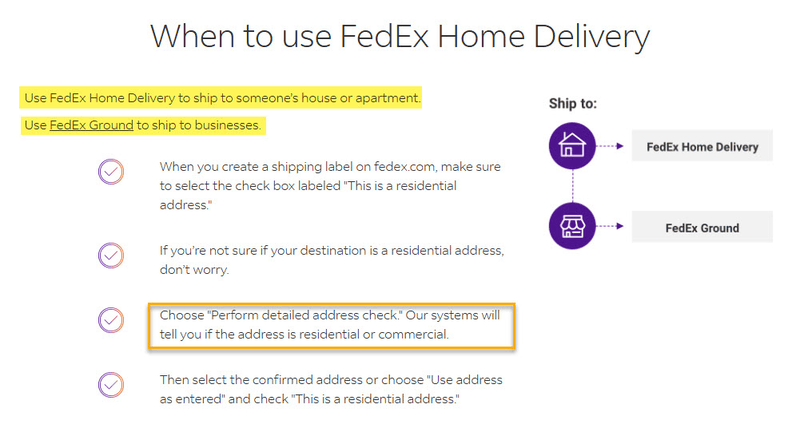
image courtesy: FedEx
You can find the complete list of surcharges for FedEx and UPS on their site here.
Carriers impose residential surcharges because, to them, it is more expensive to deliver to a residence. A courier can deliver many packages to many different businesses in a single trip to a commercial building, whereas typically a courier makes one delivery to a single residential address at a time.
It’s important to choose the right shipping service to avoid surcharges. For example, FedEx Ground is cheaper than FedEx Home Delivery, but when shipped to residential addresses, the shipper will incur a ~$4 fee that will be reflected on the invoice. Be careful not to make too many mistakes or your carrier account and negotiated rates may be negatively impacted.
Another way to avoid residential surcharges is to utilize hybrid services such as UPS SurePost and FedEx Ground Economy, (or even Amazon Shipping), all of which do not impose this fee. Also, keep in mind that hybrid services do not give you a guaranteed delivery day and take longer to deliver by design.
Also, analyzing your past shipments will help you understand just how much of a problem residential surcharges are for you so you can take action accordingly. The surcharges may not seem like much, but when shipping high-volume and utilizing a less ideal carrier/services mix, they can add up quickly.
The solution is to separate your deliveries for home and commercial addresses and select delivery methods accordingly. While we can’t force the customers to only ship to a commercial address, you can make it easier to create the correct shipping labels (and make fewer mistakes) by asking the customer to identify in the address type if it is a commercial or residential address. Lastly, there are intelligent shipping software solutions like Cahoot that provide accurate address type identification using USPS and UPS databases, along with auto-rate shopping across all carriers and services to help you ship as economically as possible.
10. Use Zone Skipping for High Volume Zones
Zone skipping is a practice of consolidating orders and shipping them together to a destination region. From there on, the parcels can be shipped individually within the destination region. The shipping cost is often calculated by the number of regions or ‘zones’ a package travels through to reach the destination. Through zone skipping, the parcel is injected into the carrier’s network directly into the destination zone. Hence, the term Zone-Skipping.
This is ideal for online Sellers with a large volume of sales within a region. If you have close to a truckload of orders from a zone every day, zone skipping is for you. Your objective should be to get your orders as close to the destination as possible in fewer stops and sorts, where the shipping carrier can pick up and deliver each package to the final destination.
For example, if you are based out of Detroit (Zone 1) and have a considerable volume of orders from Southern California (Zone 8); if you ship all your orders directly, you will pay high shipping rates for Zone 8 for all orders. With zone skipping, you can bundle all your orders going to Southern California every couple of days and send them by truck in bulk. Once in Southern California, packages are picked up by the shipping carrier and shipped within the Zone at lower rates. You save big because paying for bulk transportation is far cheaper than the difference between zone 8 and zone 1 shipping rates per unit.
Here is a snapshot of how zone skipping saved money for two online merchants:
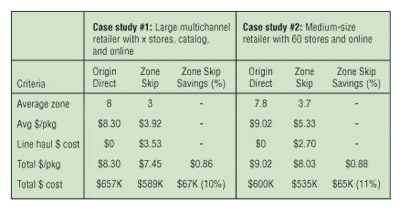
image courtesy: MultiChannelMerchant.com
USPS Parcel Select is a great complementary service to zone skipping. Under Parcel Select, Sellers drop their packages in bulk at a postal facility as close to the destination as possible. Not only, do they save on zone-skipping, but Parcel Select also offers an additional discount for bulk shipping, similar to the hybrid shipping services mentioned above. But in this case, you’re dealing directly with USPS without the intermediaries.
11. Use International Freight Forwarders to Fulfill International Orders
Shipping international from the US can be a costly affair. Besides, international shipping can be an operational headache too. There are several things to consider. You need enough manpower and time to manage the different aspects of international shipping that aren’t considerations for domestic shipments.
International Freight Forwarding services carry out the logistics operations on behalf of a firm. These generally involve, as the name suggests, large orders. But these days, a lot of freight forwarding agencies offer services tailored to ecommerce Sellers, for example, less-than-container load (LCL) services, where they bundle your parcels with other parcels to fill pallets and containers, which are then delivered to your destination country via the conventional freight network. At the destination, the last-mile delivery is done by the local postal service in the destination country.
This end-to-end process is taken care of by the freight forwarder. Online Sellers enjoy savings since they get a bulk freight discount for what is essentially parcel shipping, and only have to deal with their freight forwarder. Freight Forwarders also provide support for calculating real-time duties, taxes, and other governmental fees to present itemized final prices to customers as well as costs to Sellers before the sale is made.
In some cases, if you have an order fulfillment provider like Amazon FBA in the destination country, a freight forwarder ensures that your items reach the fulfillment provider’s warehouses.
A good example of such a service is DHL eCommerce (formerly Global Mail) which provides a solution tailored for online Sellers.
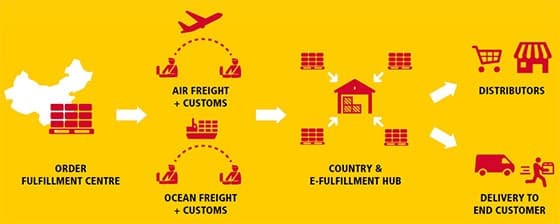
12. Selling Internationally through Full-Service Cross-Border Solutions
While domestic sales and fulfillment can be taken care of using the shipping strategies we’ve discussed so far, selling and delivering to customers in other countries is a whole other ball game.
Aside from accurately calculating shipping charges and various import fees, there are a few other things that an online Seller needs to do. To avoid surprises, your customer must understand your product’s pricing and the different tariffs included in the final landed cost. Additionally, having familiar payment options at checkout would reduce hesitancy, for example, by allowing payment via China Union Pay, WeChat, or Alipay.
Thankfully there are cross-border solutions such as Global-e’s BorderFree and International Localized Checkout that provide a comprehensive solution for selling to international customers. An end-to-end solution typically includes:
- Localization of your product content and checkout pages in locale-specific language, UI, and currency.
- Calculation of duties, taxes, and import fees for transparent final pricing to customers before the order is placed.
- Presenting and processing country-specific payment options.
- Efficient international order fulfillment using freight forwarders and other service providers.
The following checkout page is an example of an online store that uses Global-e to display the page to a Chinese customer buying from a Seller located in Australia:
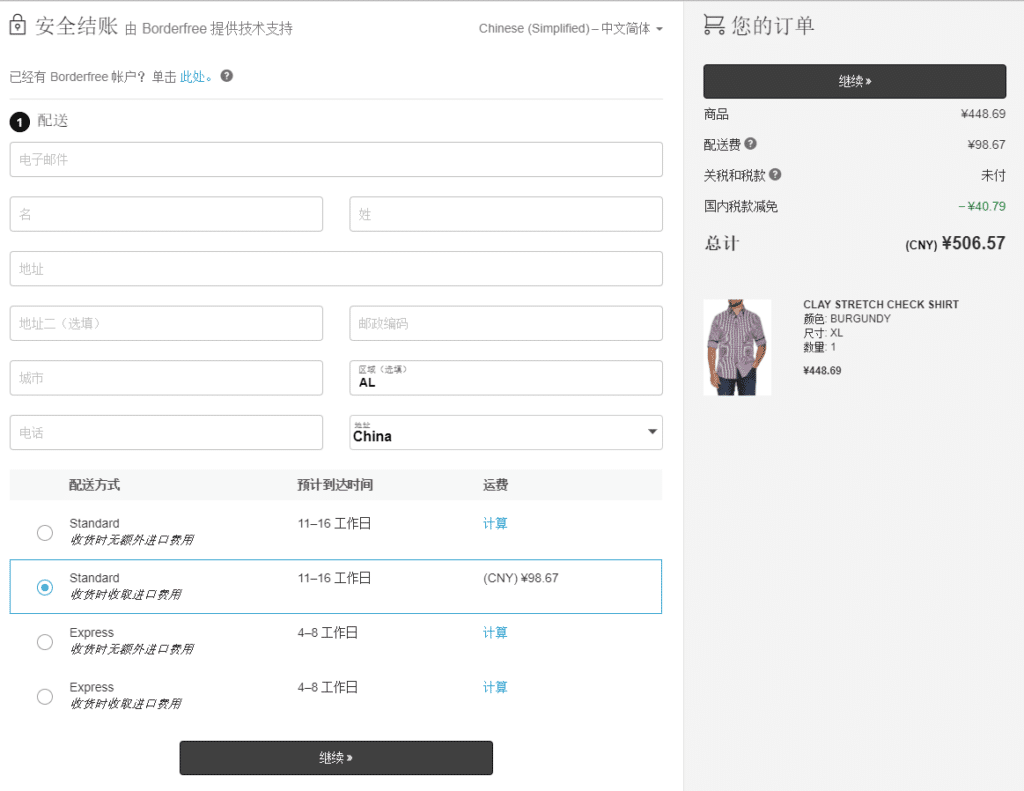
Summary
Mastering shipping isn’t just about saving a few dollars per package — it’s about building a sustainable and profitable business that encourages customer loyalty while building a scalable foundation for future growth. The strategies outlined here, from negotiating better carrier rates to leveraging hybrid shipping solutions, are designed to help you take control of your logistics instead of letting them control you. In an era where customer expectations are sky-high and operational costs are constantly climbing, businesses that optimize their shipping program can carve out an undeniable edge over competitors. Whether you’re a growing e-commerce brand or an established retailer, the right approach to shipping will not only protect your margins but also ensure a seamless experience for your customers. The key is to stay adaptable, explore new opportunities, and continually refine your strategy — because in shipping, as in business, the smartest players always come out ahead.
Download The Ultimate Guide to Profitable Free Shipping
Frequently Asked Questions
What is the most cost-effective shipping method?
Generally speaking, for standard delivery service, (1 – 5 days), USPS is the cheapest option for smaller, lighter packages that are traveling short distances, while UPS and FedEx tend to be cheaper for larger packages traveling longer distances. However hybrid shipping services where consolidator carriers accumulate and inject mass quantities of packages into the USPS network for final mile delivery take much longer to deliver, but can offer substantial savings over standard delivery services.
Does offering free shipping increase sales?
Yes, offering free shipping can increase sales. Studies show that free shipping is a key factor in purchasing decisions.
What is free shipping?
Free shipping is a marketing strategy used by online stores that allow shoppers and customers not to have to pay an additional fee when placing orders for particular items. From the online shopper’s perspective, getting no additional cost added to an item purchased makes shopping much easier.
Who really pays for free shipping?
There Is No Such Thing as “Free Shipping”. It is a fact that shipping costs are being paid for, whether consumers know it or not. Customers ultimately pay for this perk, even if it is not specified in their online shopping cart. The cost is lumped in with the final price of the goods they buy.
What is a good free shipping threshold?
Knowing how much an average customer spends per transaction can provide a better idea of what a business’ minimum order value for free shipping should be. A free shipping threshold should be about 30% above the average order value.
What is the psychology of free shipping?
The psychology of free shipping shows that customers often perceive free shipping as a better deal than a discount. This perception increases the perceived value of a purchase and encourages higher spending.
How do businesses make money with free shipping?
Free shipping can help boost sales. Shoppers believe they’re getting a better deal when they don’t have to pay for shipping costs which can help increase cart sizes. Customers will buy more to get free shipping and will take their business elsewhere if they can’t.

Up to 64% Lower Returns Processing Cost

Fulfillment Center vs Distribution Center: Understanding the Supply Chain Ecosystem
In today’s complex supply chain landscape, terminology can sometimes blur together, leaving business owners and logistics professionals confused about the best solutions for their operations. Two terms that are often used interchangeably, yet serve distinctly different purposes, are fulfillment centers and distribution centers. This article explores their definitions, differences, relationships, and how they fit into the broader supply chain ecosystem alongside traditional warehouses.
What is a Fulfillment Center
A fulfillment center (FC) is a specialized facility primarily focused on B2C (business-to-consumer) operations. These centers receive, process, pack, and ship orders directly to end consumers. The key distinguishing feature of fulfillment centers is their consumer-oriented approach. They are designed to handle individual orders rather than bulk shipments, with workflows optimized for picking single items from inventory, packaging them appropriately for individual consumers, and shipping them through parcel carriers.
A fulfillment warehouse, often managed by third-party logistics providers, operates similarly to a fulfillment center, focusing on efficiently shipping goods, particularly for ecommerce and retail.
The primary goal of a fulfillment center is speed and accuracy in getting products directly into customers’ hands. They typically store inventory for relatively short periods; just long enough to facilitate the order fulfillment process. Modern fulfillment centers often feature advanced automation systems for sorting, picking, and packing to meet the growing demands of ecommerce.
Benefits for Ecommerce Businesses
Fulfillment centers offer a multitude of benefits for ecommerce businesses, making them a necessary component of modern online retail operations. These benefits include:
- Speed and Efficiency in Fulfilling Customer Orders: Fulfillment centers are designed to process individual customer orders quickly and accurately. With advanced automation and streamlined workflows, these centers can pick, pack, and ship orders with remarkable speed, meeting the high expectations of today’s consumers for fast delivery.
- Scalability to Accommodate Fluctuating Order Volumes: Ecommerce businesses often experience varying order volumes due to seasonal trends, promotions, and market fluctuations. Fulfillment centers provide the scalability needed to handle these changes, allowing businesses to ramp up operations during peak periods and scale down during slower times without compromising efficiency.
- Focus on Customer Experience: By outsourcing order fulfillment to specialized centers, ecommerce businesses can focus on their core activities, such as product development, marketing, and customer service. Fulfillment centers also offer value-added services like gift wrapping, personalized notes, and custom packaging, enhancing the overall customer experience and fostering brand loyalty.
- Access to Advanced Technology and Automation: Fulfillment centers leverage cutting-edge technology and automation to optimize the entire order fulfillment process. From robotic picking systems to real-time inventory tracking, these technological advancements enable businesses to stay competitive in the fast-paced ecommerce market.
- Cost Savings through Reduced Shipping Costs and Improved Inventory Management: By strategically locating fulfillment centers near customer population centers, businesses can reduce shipping costs and transit times. Additionally, advanced inventory management systems help minimize stockouts and overstock situations, leading to more efficient use of resources and cost savings.
In summary, fulfillment centers provide ecommerce businesses with the tools and capabilities needed to meet customer demands, streamline operations, and achieve sustainable growth in a competitive market.
What is a Distribution Center
Distribution centers (DC), by contrast, serve primarily as waypoints in the supply chain. Distribution centers serve as essential hubs that receive and store inventory, which is then allocated to fulfillment centers for order processing. They focus on B2B (business-to-business) operations, acting as intermediaries that receive bulk shipments from manufacturers or suppliers and then redistribute these goods to other business locations such as retail stores, smaller regional distribution centers, or sometimes fulfillment centers.
The key function of a distribution center is short-term storage and efficient product flow. Inventory typically moves through a distribution center quickly, usually within days or weeks, as these facilities are designed for high throughput rather than long-term storage. They handle merchandise in larger quantities (pallets or cases rather than individual items) and focus on efficient cross-docking, sorting, and redistribution operations.
In essence, distribution centers act as strategic hubs within the supply chain, ensuring that products are efficiently moved from one point to another. This makes them crucial for businesses involved in wholesale distribution and retail replenishment, as they help maintain a steady flow of inventory to meet market demands. By serving as central points for receiving and storing inventory, distribution centers enable businesses to manage their supply chains more effectively, ensuring that products are available where and when they are needed.
Benefits for Ecommerce Businesses
Distribution centers are equipped with several key features that enable them to manage inventory efficiently and distribute products effectively. These features include:
- Inventory Management and Storage Capabilities: Distribution centers are designed to manage inventory levels meticulously and store products in an organized manner. Advanced inventory management systems are often employed to track stock levels, monitor product movement, and ensure that inventory is readily available for redistribution.
- Order Fulfillment to Various Locations: One of the primary functions of a distribution center is to fulfill orders to various locations, including retail stores, wholesalers, or other fulfillment centers. This involves picking, packing, and shipping products in bulk, ensuring that each destination receives the correct quantities of inventory.
- Cross-Docking and Consolidation Capabilities: Distribution centers often utilize cross-docking and consolidation techniques to minimize handling and storage costs. Cross-docking involves transferring products directly from inbound to outbound transportation with minimal storage time, while consolidation combines smaller shipments into larger ones to optimize transportation efficiency and reduce transit times.
- Partnerships with Shipping Carriers: To ensure timely and cost-effective delivery, distribution centers often establish partnerships with various shipping carriers. These partnerships enable distribution centers to negotiate favorable shipping rates, streamline logistics operations, and ensure that products reach their destinations promptly.
By incorporating these features, distribution centers can effectively manage the flow of inventory, reduce operational costs, and enhance overall supply chain efficiency.
What is a Warehouse
Warehouses represent the traditional model of storage facilities, designed for longer-term inventory storage. Unlike fulfillment and distribution centers that prioritize movement, warehouses are designed for longer-term inventory storage, often holding goods for months or even years. They serve as repositories for raw materials, seasonal inventory, safety stock, or slow-moving products.
Not all warehouses are fulfillment centers or distribution centers. Not all fulfillment centers or distribution centers are warehouses.
The primary function of a warehouse is secure, organized storage rather than rapid processing or shipping. While modern warehouses have evolved to incorporate more sophisticated inventory management systems, their fundamental purpose remains focused on storage capacity and organization rather than rapid throughput.
Fulfillment Centers and Distribution Centers Complement Each Other
Rather than competing entities, fulfillment centers and distribution centers typically operate as complementary components within a sophisticated supply chain network. Many businesses rely on a third party logistics company (3PL) to manage the operations of both fulfillment centers and distribution centers, ensuring efficient movement of goods from manufacturers to consumers. In many large operations, distribution centers feed fulfillment centers, creating a logical flow of goods from manufacturer to consumer.
In this relationship, distribution centers typically receive bulk shipments from manufacturers, then break these large shipments down into smaller quantities that are sent to various fulfillment centers based on regional demand forecasts. The fulfillment centers positioned closer to end consumers handle the final mile of the delivery process.
This collaboration creates a streamlined supply chain that balances efficiency with customer satisfaction. Distribution centers provide the economies of scale needed for cost-effective inventory movement, while fulfillment centers deliver the speed and personalization that today’s consumers demand.
How Warehouses Fit into the FC and DC Ecosystem
Traditional warehouses serve a different but equally important role in the supply chain ecosystem. While fulfillment and distribution centers focus on movement and flow, warehouses provide stability and security through longer-term storage capabilities.
Warehouses often feed both distribution and fulfillment centers with inventory as needed, providing essential warehouse space for excess inventory during low-demand periods. They store excess inventory during low-demand periods, hold seasonal merchandise until the appropriate selling season, maintain safety stock to buffer against supply chain disruptions, and house slow-moving items that aren’t needed in high-velocity centers.
In a well-designed supply chain, warehouses act as the foundation that supports the more dynamic operations of distribution and fulfillment centers. They provide the buffer needed to maintain consistent inventory availability despite fluctuations in demand or supply chain disruptions.
How to Choose the Right Facilities
Selecting the appropriate mix of fulfillment centers, distribution centers, and warehouses depends on several factors specific to your business model and operations.
Using Fulfillment Centers Exclusively
Businesses that rely solely on fulfillment centers gain significant advantages in direct-to-consumer operations. These facilities excel at processing individual customer orders with speed and precision, enabling faster delivery times that meet the growing expectations of today’s consumers. These facilities also provide pack fulfillment services, which include generating pick lists, collecting items, checking orders for accuracy, and packing them for shipping. The specialized handling capabilities of fulfillment centers ensure that each order receives proper attention, from accurate picking to appropriate packaging, enhancing overall customer satisfaction.
Another major benefit of fulfillment centers is their ability to offer value-added services that enhance the customer experience. From gift wrapping and personalized notes to custom packaging and subscription box assembly, these facilities can implement services that create memorable unboxing experiences and strengthen brand loyalty. This consumer-focused approach makes fulfillment centers particularly well-suited for ecommerce operations, where the physical delivery represents a critical touchpoint in the customer journey.
However, relying exclusively on fulfillment centers comes with several drawbacks that businesses must consider. These facilities typically incur higher operational costs per unit handled compared to other supply chain facilities. The labor-intensive nature of individual order processing, combined with the premium locations needed for rapid delivery, contributes to increased expenses that can impact profit margins. Additionally, fulfillment centers are not designed for efficient bulk storage, making them less cost-effective for inventory that isn’t actively moving to consumers.
Businesses using only fulfillment centers may also struggle with limited capacity for long-term inventory holding. These facilities prioritize throughput over storage, making them ill-suited for housing seasonal merchandise, safety stock, or slow-moving items. For nationwide operations, a fulfillment center-only approach often necessitates establishing multiple facilities across different regions to achieve acceptable delivery timeframes, further increasing operational complexity and capital requirements.
Using Distribution Centers Exclusively
Organizations that operate exclusively with distribution centers serve benefit from highly efficient handling of bulk shipments. These facilities excel at receiving, sorting, and redistributing large quantities of merchandise, creating significant economies of scale in inventory movement. Their focus on high-volume handling makes them particularly cost-effective for businesses that primarily serve other businesses rather than individual consumers.
The strategic positioning of distribution centers enables efficient regional distribution networks that can minimize transportation costs while maximizing coverage. By placing these facilities near major transportation hubs or at crossroads between manufacturing sources and market destinations, companies can optimize their outbound logistics operations. This creates better economies of scale for transportation, allowing businesses to negotiate more favorable carrier rates and reduce per-unit shipping costs through consolidated freight movements.
Distribution centers provide an ideal infrastructure for retail store supply chains, efficiently breaking down bulk shipments into store-specific allocations that can be delivered according to retail replenishment schedules. Their ability to process large volumes of merchandise makes them well-suited for operations where goods flow to predetermined business locations rather than individual households.
Despite these advantages, a distribution center-only approach presents significant limitations for many modern businesses. These facilities are not optimized for individual order fulfillment, lacking the specialized processes and systems needed for efficient picking, packing, and shipping of direct-to-consumer orders. Their focus on bulk handling makes them less suitable for the personalized, parcel-based shipping that dominates ecommerce operations.
Businesses relying solely on distribution centers for ecommerce operations often encounter additional handling steps that increase both costs and fulfillment timelines. Without dedicated fulfillment capabilities, companies frequently need to partner with separate fulfillment services or carriers to bridge the gap between their distribution operations and individual consumer deliveries, adding complexity and reducing control over the customer experience.
Using Warehouses Exclusively
Companies that utilize storage facilities as their sole supply chain facility enjoy substantial benefits for long-term storage operations. These facilities offer lower operational costs for inventory that doesn’t require frequent handling, making them cost-effective solutions for businesses with stable product lines or significant safety stock requirements. Their focus on storage rather than processing provides the capacity to house large quantities of inventory efficiently, utilizing vertical space and dense storage solutions.
Warehouses provide ideal environments for maintaining significant safety stock levels to buffer against supply chain disruptions or demand fluctuations. Their long-term storage orientation makes them particularly well-suited for seasonal or slow-moving inventory that would otherwise consume valuable space in more dynamic facilities. Many warehouses can be established in less premium locations away from urban centers, resulting in lower real estate costs and reduced overhead expenses compared to fulfillment or distribution centers.
However, a warehouse-only approach creates substantial challenges for serving today’s consumers effectively. These facilities are not designed for rapid order processing, lacking the workflows and systems needed to efficiently fulfill individual customer orders. Without specialized consumer packaging capabilities, warehouses struggle to provide the presentation quality and unboxing experience that modern shoppers expect from online purchases.
Warehouses are typically positioned farther from end consumers than fulfillment centers, increasing delivery timelines and transportation costs for direct-to-consumer shipments. The storage-focused nature of these facilities often requires more labor to transition goods from storage mode to shipping mode, creating operational inefficiencies when handling ecommerce orders. For businesses serving individual consumers, these limitations can significantly impact customer satisfaction and competitive positioning.
Integrating All Three Facilities
Organizations that successfully integrate fulfillment centers, distribution centers, and warehouses into a cohesive network gain maximum flexibility across all supply chain needs. This comprehensive approach allows businesses to leverage the strengths of each facility type while mitigating their individual limitations. By designating specific functions to the facilities best suited to perform them, companies can optimize each location for its intended purpose, improving overall operational efficiency and cost-effectiveness.
Many businesses rely on a third party logistics company (3PL) to manage the operations of fulfillment centers, distribution centers, and warehouses, ensuring efficient movement of goods across the supply chain.
An integrated approach provides better regional coverage and delivery capabilities, positioning inventory strategically to balance cost efficiency with customer service requirements. By maintaining warehouses for long-term storage, distribution centers for regional replenishment, and fulfillment centers for consumer deliveries, businesses create more robust contingency options during supply chain disruptions. This multi-facility network also offers enhanced scalability for seasonal fluctuations, allowing companies to adjust capacity and capabilities as demand patterns change throughout the year.
While integration offers numerous advantages, it also introduces greater complexity into supply chain operations. Managing inventory effectively across multiple facility types requires sophisticated inventory management systems and careful coordination to prevent stockouts or redundancies. The movement of goods between facilities increases transportation costs compared to simpler supply chain structures, potentially offsetting some of the efficiency gains achieved through specialization.
Integrated networks typically require more sophisticated tracking systems to maintain visibility and control across the extended supply chain. The multi-facility approach also creates greater management overhead, as each facility type demands different operational expertise and oversight. The combined real estate, equipment, and staffing requirements of multiple facility types result in higher total infrastructure costs, although these investments often generate positive returns through improved service capabilities and operational efficiency.
Global vs Domestic Considerations
The global nature of today’s supply chains adds another layer of complexity to facility planning. International operations typically require adjustments to the traditional model:
- Global Distribution Centers often function as import processing centers, handling customs clearance, compliance verification, and international shipment consolidation. These facilities typically require proximity to ports, airports, or border crossings.
- Regional Fulfillment Networks become even more critical in global operations, as fulfillment centers must be strategically positioned to meet delivery expectations across different countries while navigating varying regulations and shipping infrastructures.
- International Warehousing may involve bonded warehouses, free trade zones, or other specialized facilities that help mitigate duties, taxes, or compliance issues associated with international commerce.
Conclusion
Understanding and taking advantage of the distinctions between fulfillment centers, distribution centers, and warehouses helps develop an effective supply chain strategy. Rather than viewing these facilities as interchangeable or competing options, successful businesses recognize them as complementary components of a comprehensive logistics ecosystem.
By strategically implementing the right mix of facilities based on your specific business needs, you can create a supply chain that balances cost efficiency with customer satisfaction. The optimal approach typically involves integrating elements of all three facility types, with their relative importance determined by your business model, customer expectations, and growth strategy. Cahoot can help you find the right mix and help your business grow no matter what.
As ecommerce continues to evolve and consumer expectations for rapid delivery increase, the strategic importance of well-designed fulfillment networks will only grow. Businesses that understand and effectively leverage the unique strengths of each facility type will gain significant competitive advantages in the marketplace.
Frequently Asked Questions
Are Distribution Centers and Fulfillment Centers Warehouses?
Not all distribution centers and fulfillment centers have long-term warehouse space capabilities. Most will support storage, but the storage fees may be much higher than using a dedicated warehouse.
Can a Distribution Center also act as a Fulfillment Center?
Yes, some distribution centers may offer fulfillment services.
What Location Differences are there Between Fulfillment Centers and Distribution Centers?
Fulfillment centers are located near customer population centers, while distribution centers are focused on shipping hubs. These locations have some overlap, but that doesn’t mean that a distribution center makes a good fulfillment center.

Up to 64% Lower Returns Processing Cost

Modern Order Fulfillment Strategies for Ecommerce Success
In today’s fiercely competitive ecommerce landscape, ecommerce order fulfillment has evolved from a back-office operation to a critical strategic advantage. The journey from customer order to delivery can make or break businesses, influencing everything from customer loyalty to profit margins. Effective order fulfillment isn’t merely about moving products from point A to point B; it’s about creating a seamless experience that meets rising consumer expectations while maintaining operational efficiency.
In today’s competitive market, customers expect fast, reliable, and affordable shipping options. As a result, ecommerce businesses must prioritize order fulfillment to meet customer expectations and stay ahead of the competition. The foundation of successful ecommerce fulfillment begins with selecting the right fulfillment model for your business needs.
What is Order Fulfillment?
Order fulfillment processes involve receiving, processing, and shipping orders to customers. It encompasses several key activities, including managing inventory, picking and packing orders, and ensuring timely delivery to customers. A well-executed order fulfillment strategy ensures that customers receive their orders accurately and promptly, enhancing their overall shopping experience and encouraging repeat business.
Benefits of Optimizing Order Fulfillment
Optimizing order fulfillment can bring numerous benefits to ecommerce businesses. Some of the key benefits include:
- Improved Customer Satisfaction: Fast and reliable shipping options can significantly enhance customer satisfaction and loyalty. When customers receive their orders quickly and accurately, they are more likely to return for future purchases.
- Increased Efficiency: Streamlining the order fulfillment process can reduce costs and improve operational efficiency. By automating tasks and optimizing workflows, businesses can handle higher order volumes with fewer resources.
- Competitive Advantage: Offering fast and affordable shipping options can give ecommerce businesses a competitive edge in the market. Customers are more likely to choose retailers that provide superior delivery experiences.
- Increased Sales: Optimizing order fulfillment can lead to increased sales and revenue. Satisfied customers are more likely to make repeat purchases and recommend the business to others.
By focusing on these benefits, ecommerce businesses can create a more efficient and customer-centric order fulfillment process, driving long-term success.
The Order Fulfillment Process
The order fulfillment process involves a series of steps that ensure customer orders are received, processed, and delivered efficiently and effectively. In this section, we will break down the order fulfillment process into its key components and explore each step in detail.
Receiving and Inventory Management
Receiving and inventory management is the first step in the order fulfillment process, even before customers place orders. This involves receiving and storing inventory in a warehouse or fulfillment center. Effective inventory management includes tracking inventory levels, monitoring stock levels, and ensuring that products are stored in a way that prevents damage or loss.
Order Processing and Picking
Order processing and picking is the next step in the order fulfillment process. This involves processing customer orders, picking the relevant products from inventory, and preparing them for shipping. Efficient order processing and picking includes using picking strategies such as zone picking or batch picking to minimize travel time.
Shipping and Delivery
Shipping and delivery are the final steps in the order fulfillment process. This involves shipping orders to customers and ensuring that they are delivered on time. Efficient shipping and delivery meet customer expectations while still keeping shipping costs low.
Order Fulfillment Solutions
#1 – In-House Fulfillment
In-house fulfillment provides complete control over the entire process, allowing companies to oversee quality control, packaging, and shipping directly. This approach works particularly well for businesses with unique products requiring special packaging or handling, those with low order volumes, or companies selling high-value items where the unboxing experience serves as a brand differentiator.
However, in-house fulfillment requires significant investment in warehouse space, equipment, technology, and labor. As such, it usually operates out of a single location, which comes with additional shipping costs. It also creates challenges during seasonal peaks when order volumes can surge dramatically, potentially overwhelming internal resources and leading to delays.
#2 – 3PL Fulfillment
For many growing ecommerce businesses, third-party logistics (3PL) providers offer a compelling alternative to in-house fulfillment. These specialized companies manage warehousing, picking, packing, and shipping operations, allowing online retailers to focus on core competencies like product development and marketing. The 3PL approach offers several advantages: veteran fulfillment staff, scalability to handle growth and seasonal fluctuations, geographic distribution to reduce shipping times and costs, and access to advanced fulfillment technologies without capital investment.
Most importantly, 3PLs spread their fixed costs across multiple clients, creating economies of scale that can significantly reduce per-order fulfillment costs. However, businesses must carefully evaluate potential 3PL partners based on industry expertise, technology capabilities, geographic coverage, and reliability metrics before outsourcing this critical function.
#3 – Dropshipping
Dropshipping represents another fulfillment model that has gained popularity, particularly among new ecommerce entrepreneurs. In this approach, retailers don’t hold inventory at all; instead, when a customer places an order, the retailer purchases the item from a third-party supplier who ships directly to the customer. Dropshipping eliminates inventory investment, warehousing costs, and fulfillment operations, allowing for leaner operations and reduced financial risk. However, this model creates dependency on suppliers for product quality and shipping times, limiting control over the customer experience. Retailers using dropshipping must establish strong supplier relationships and clear performance expectations to maintain customer satisfaction.
Challenges and Complications
Inventory Management
Inventory management represents perhaps the most challenging aspect of ecommerce fulfillment. Too much inventory ties up capital and increases storage costs, while too little leads to stockouts and disappointed customers. Advanced inventory forecasting tools now use artificial intelligence and machine learning to analyze historical sales data, seasonal patterns, market trends, and even social media signals to predict demand with remarkable accuracy.
The rise of omnichannel retail has further complicated inventory management, requiring seamless integration between online and offline channels. Leading retailers now implement unified inventory systems that provide a single view of stock across ecommerce, physical stores, and distribution centers. This integration enables practices like ship-from-store, where retail locations fulfill online orders for nearby customers, and buy-online-pickup-in-store (BOPIS), which has grown tremendously since the pandemic. Effective omnichannel inventory management requires not just technological integration but also organizational alignment, breaking down silos between traditional retail and ecommerce operations.
Technology and Automation Necessities
Warehouse operations themselves have undergone dramatic transformation through automation and digitalization. Modern ecommerce fulfillment centers utilize warehouse management systems (WMS) to orchestrate the flow of products and information. These systems optimize pick paths to minimize worker travel time, direct batch picking operations for greater efficiency, and ensure accurate inventory counts. Mobile devices and wearable technology provide warehouse staff with real-time instructions and verification capabilities, reducing error rates.
Integrated technology stacks now connect ecommerce platforms, order management systems, warehouse management systems, transportation management systems, and customer service platforms. This integration enables real-time inventory visibility, automated order routing, dynamic carrier selection, and proactive exception management. For customers, it provides accurate delivery promises during shopping, consistent order status updates, and seamless communication across touchpoints. The most advanced systems leverage artificial intelligence to continuously optimize decisions, from inventory placement to shipping method selection, ensuring the optimal balance of service level and cost for each order.
How can in-house fulfillment technologically keep up without exorbitant cost?
Returns on the Rise
Returns management has evolved from an afterthought to a critical component of ecommerce fulfillment strategy. Online purchases are returned at three to four times the rate of in-store purchases, creating significant operational challenges and costs.
Progressive retailers now view returns as an opportunity to enhance customer loyalty rather than a necessary evil. Streamlined return policies, prepaid return labels, and convenient drop-off options reduce friction for customers. Behind the scenes, sellers must stay vigilant for patterns that may indicate fraud or quality issues requiring attention. Effective returns management doesn’t just mitigate costs; it creates opportunities to recover value and improve customer satisfaction.
The Future of Fulfillment
The future of ecommerce fulfillment points toward even greater personalization and sustainability. Customers increasingly expect delivery experiences tailored to their preferences—from packaging options to delivery windows to unboxing experiences. Simultaneously, environmental concerns are driving innovation in sustainable packaging, optimized delivery routes, and circular supply chains that minimize waste. Forward-thinking retailers are exploring micro-fulfillment centers within urban areas, using existing retail space for rapid order processing. Emerging technologies like predictive shipping, where orders are positioned in the distribution network before purchase based on forecasted demand, promise to further reduce delivery times while maintaining efficiency.
Conclusion
Ultimately, successful ecommerce fulfillment requires balancing sometimes conflicting priorities; customer experience, operational efficiency, and financial performance. Cahoot can help improve all aspects, while keeping costs down.
The most successful ecommerce businesses view fulfillment not as a cost center but as a strategic differentiator; one that delivers not just packages, but competitive advantage in an increasingly crowded marketplace.
Frequently Asked Questions
Should I handle fulfillment myself or use a 3PL?
As sales volume grows, 3PLs become more attractive to small businesses. A quick heuristic would be checking air vs ground shipping costs; having multiple warehouses helps cut down on expensive shipping.
What are some good KPIs to monitor?
Good KPIs for Order Fulfillment are Order Picking Accuracy (Correctly Picked Orders ÷ Total Orders Picked) and Order Cycle Time (Average Time from Order Receipt to Shipment)
How can I package orders efficiently?
Optimizing packaging is a great way to save on shipping costs. This is easy for single item orders, but multiple item orders and juggling many boxes swiftly becomes exponentially more difficult. Smart cartonization software automates this complexity.

Up to 64% Lower Returns Processing Cost

